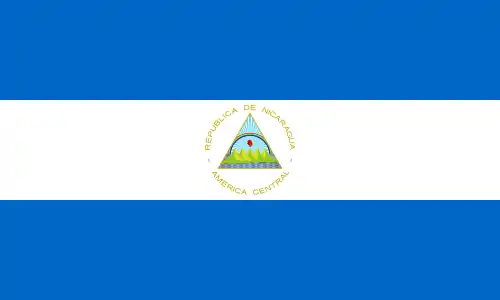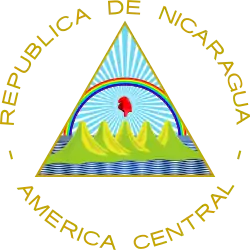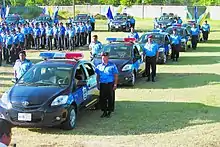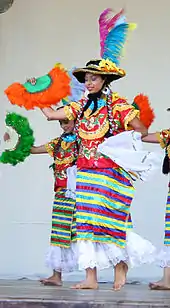Nicaragua
Nicaragua (/ˌnɪkəˈrɑːɡwə, -ˈræɡ-, -ɡjuə/ (![]() listen); Spanish: [nikaˈɾaɣwa] (
listen); Spanish: [nikaˈɾaɣwa] (![]() listen)), officially the Republic of Nicaragua (Spanish:
listen)), officially the Republic of Nicaragua (Spanish: ![]() República de Nicaragua ), is the largest country in the Central American isthmus, bordered by Honduras to the northwest, the Caribbean to the east, Costa Rica to the south, and the Pacific Ocean to the southwest. Managua is the country's capital and largest city and is also the third-largest city in Central America, behind Tegucigalpa and Guatemala City. The multi-ethnic population of six million includes people of indigenous, European, African, and Asian heritage. The main language is Spanish. Indigenous tribes on the Mosquito Coast speak their own languages and English.
República de Nicaragua ), is the largest country in the Central American isthmus, bordered by Honduras to the northwest, the Caribbean to the east, Costa Rica to the south, and the Pacific Ocean to the southwest. Managua is the country's capital and largest city and is also the third-largest city in Central America, behind Tegucigalpa and Guatemala City. The multi-ethnic population of six million includes people of indigenous, European, African, and Asian heritage. The main language is Spanish. Indigenous tribes on the Mosquito Coast speak their own languages and English.
Republic of Nicaragua República de Nicaragua (Spanish) | |
|---|---|
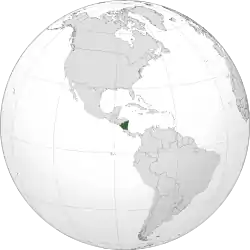 | |
| Capital and largest city | Managua 12°6′N 86°14′W |
| Official languages | Spanish |
| Recognised regional languages | |
| Ethnic groups (2011[2]) |
|
| Religion | 84.4% Christianity —55.0% Catholic —27.2% Protestant —2.2% Other Christian 14.7% No religion 0.9% Other religions |
| Demonym(s) | Nicaraguan |
| Government | Unitary dominant-party presidential constitutional republic |
| Daniel Ortega | |
| Rosario Murillo | |
| Legislature | National Assembly |
| Independence from Spain, Mexico and the Federal Republic of Central America | |
• Declared | 15 September 1821 |
• Recognized | 25 July 1850 |
• from the First Mexican Empire | 1 July 1823 |
• from the Federal Republic of Central America | 31 May 1838 |
• Revolution | 19 July 1979 |
• Current constitution | 9 January 1987[5] |
| Area | |
• Total | 130,375 km2 (50,338 sq mi) (96th) |
• Water (%) | 7.14 |
| Population | |
• 2019 estimate | 6,486,201[6] (112th) |
• 2012 census | 6,071,045[7] |
• Density | 51/km2 (132.1/sq mi) (155th) |
| GDP (PPP) | 2018 estimate |
• Total | $35.757 billion[8] (115th) |
• Per capita | $5,683[8] (129th) |
| GDP (nominal) | 2018 estimate |
• Total | $13.380 billion[8] (127th) |
• Per capita | $2,126[8] (134th) |
| Gini (2014) | 46.2[9] high |
| HDI (2019) | medium · 128th |
| Currency | Córdoba (NIO) |
| Time zone | UTC−6 (CST) |
| Driving side | right |
| Calling code | +505 |
| ISO 3166 code | NI |
| Internet TLD | .ni |
Originally inhabited by various indigenous cultures since ancient times, the region was conquered by the Spanish Empire in the 16th century. Nicaragua gained independence from Spain in 1821. The Mosquito Coast followed a different historical path, being colonized by the English in the 17th century and later coming under British rule. It became an autonomous territory of Nicaragua in 1860 and its northernmost part was transferred to Honduras in 1960. Since its independence, Nicaragua has undergone periods of political unrest, dictatorship, occupation and fiscal crisis, including the Nicaraguan Revolution of the 1960s and 1970s and the Contra War of the 1980s.
The mixture of cultural traditions has generated substantial diversity in folklore, cuisine, music, and literature, particularly the latter, given the literary contributions of Nicaraguan poets and writers such as Rubén Darío. Known as the "land of lakes and volcanoes",[11][12] Nicaragua is also home to the second-largest rainforest of the Americas. The biological diversity, warm tropical climate and active volcanoes make Nicaragua an increasingly popular tourist destination.[13][14]
Etymology
There are two prevailing theories on how the name "Nicaragua" came to be. The first is that the name was coined by Spanish colonists based on the name Nicarao,[15] who was the chieftain or cacique of a powerful indigenous tribe encountered by the Spanish conquistador Gil González Dávila during his entry into southwestern Nicaragua in 1522. This theory holds that the name Nicaragua was formed from Nicarao and agua (Spanish for "water"), to reference the fact that there are two large lakes and several other bodies of water within the country.[16] However, as of 2002, it was determined that the cacique's real name was Macuilmiquiztli, which meant "Five Deaths" in the Nahuatl language, rather than Nicarao.[17][18][19][20]
The second theory is that the country's name comes from any of the following Nahuatl words: nic-anahuac, which meant "Anahuac reached this far", or "the Nahuas came this far", or "those who come from Anahuac came this far"; nican-nahua, which meant "here are the Nahuas"; or nic-atl-nahuac, which meant "here by the water" or "surrounded by water".[15][16][21][22]
History
Pre-Columbian history
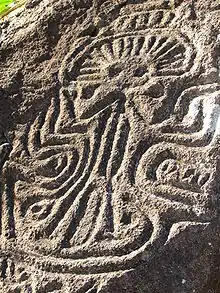
Paleo-Americans first inhabited what is now known as Nicaragua as far back as 12,000 BCE.[23] In later pre-Columbian times, Nicaragua's indigenous people were part of the Intermediate Area,[24]:33 between the Mesoamerican and Andean cultural regions, and within the influence of the Isthmo-Colombian area. Nicaragua's central region and its Caribbean coast were inhabited by Macro-Chibchan language ethnic groups.[24]:20 They had coalesced in Central America and migrated also to present-day northern Colombia and nearby areas.[25] They lived a life based primarily on hunting and gathering, as well as fishing, and performing slash-and-burn agriculture.[24]:33[26][27]:65
At the end of the 15th century, western Nicaragua was inhabited by several different indigenous peoples related by culture to the Mesoamerican civilizations of the Toltec and Maya, and by language to the Mesoamerican Linguistic Area.[28] The Chorotegas were Mangue language ethnic groups who had arrived in Nicaragua from what is now the Mexican state of Chiapas sometime around 800 CE.[21][27]:26–33 The Pipil-Nicarao people were a branch of Nahuas who spoke the Nahuat dialect, and like the Chorotegas, they too had come from Chiapas to Nicaragua in approximately 1200 CE.[29] Prior to that, the Pipil-Nicaraos had been associated with the Toltec civilization.[27]:26–33[29][30][31][32] Both the Chorotegas and the Pipil-Nicaraos were originally from Mexico's Cholula valley,[29] and had gradually migrated southward.[27]:26–33 Additionally, there were trade-related colonies in Nicaragua that had been set up by the Aztecs starting in the 14th century.[27]:26–33
Spanish era (1523–1821)
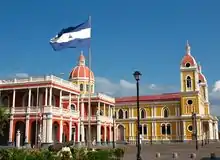
In 1502, on his fourth voyage, Christopher Columbus became the first European known to have reached what is now Nicaragua as he sailed southeast toward the Isthmus of Panama.[24]:193[27]:92 Columbus explored the Mosquito Coast on the Atlantic side of Nicaragua[33] but did not encounter any indigenous people. 20 years later, the Spaniards returned to Nicaragua, this time to its southwestern part. The first attempt to conquer Nicaragua was by the conquistador Gil González Dávila,[34] who had arrived in Panama in January 1520. In 1522, González Dávila ventured into the area that later became known as the Rivas Department of Nicaragua.[24]:35[27]:92 It was there that he encountered an indigenous Nahua tribe led by a chieftain named Macuilmiquiztli, whose name has sometimes been erroneously referred to as "Nicarao" or "Nicaragua". At the time, the tribe's capital city was called Quauhcapolca.[20][35][36] González Dávila had brought along two indigenous interpreters who had been taught the Spanish language, and thus he was able to have a discourse with Macuilmiquiztli.[19] After exploring and gathering gold[20][24]:35[27]:55 in the fertile western valleys, González Dávila and his men were attacked and driven off by the Chorotega, led by the chieftain Diriangén.[20][37] The Spanish attempted to convert the tribes to Christianity; the people in Macuilmiquiztli's tribe were baptized,[20][27]:86 but Diriangén, however, was openly hostile to the Spaniards.
The first Spanish permanent settlements were founded in 1524.[34] That year, the conquistador Francisco Hernández de Córdoba founded two of Nicaragua's principal cities: Granada on Lake Nicaragua was the first settlement, followed by León at a location west of Lake Managua.[24]:35, 193[27]:92 Córdoba soon built defenses for the cities and fought against incursions by other conquistadors.[27]:92 Córdoba was later publicly beheaded as a consequence for having defied the authority of his superior, Pedro Arias Dávila.[24]:35 Córdoba's tomb and remains were discovered in 2000 in the ruins of León Viejo.[38]
The clashes among Spanish forces did not impede their destruction of the indigenous people and their culture. The series of battles came to be known as the "War of the Captains".[39] Pedro Arias Dávila was a winner;[24]:35 although he had lost control of Panama, he moved to Nicaragua and successfully established his base in León.[40] In 1527, León became the capital of the colony.[27]:93[40] Through adroit diplomatic machinations, Arias Dávila became the colony's first governor.[38]
Without women in their parties,[27]:123 the Spanish conquerors took Nahua and Chorotega wives and partners, beginning the multiethnic mix of indigenous and European stock now known as "mestizo", which constitutes the great majority of the population in western Nicaragua.[28] Many indigenous people died as a result of new infectious diseases, compounded by neglect by the Spaniards, who controlled their subsistence.[34] Furthermore, a large number of other indigenous peoples were captured and transported to Panama and Peru between 1526 and 1540, where they were forced to perform slave labor.[24]:193[27]:104–105
In 1610, the Momotombo volcano erupted, destroying the city of León.[41] The city was rebuilt northwest of the original,[40][41] which is now known as the ruins of León Viejo. During the American Revolutionary War, Central America was subject to conflict between Britain and Spain. British navy admiral Horatio Nelson led expeditions in the Battle of San Fernando de Omoa in 1779 and on the San Juan River in 1780, the latter of which had temporary success before being abandoned due to disease.
Independence (1821)
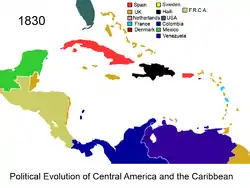
The Captaincy General of Guatemala was dissolved in September 1821 with the Act of Independence of Central America, and Nicaragua soon became part of the First Mexican Empire. After the monarchy of the First Mexican Empire was overthrown in 1823, Nicaragua joined the newly formed United Provinces of Central America, which was later renamed as the Federal Republic of Central America. Nicaragua finally became an independent republic in 1838.[42]
Rivalry between the Liberal elite of León and the Conservative elite of Granada characterized the early years of independence and often degenerated into civil war, particularly during the 1840s and 1850s. Managua was chosen as the nation's capital in 1852 to allay the rivalry between the two feuding cities.[43][44] During the days of the California Gold Rush, Nicaragua provided a route for travelers from the eastern United States to journey to California by sea, via the use of the San Juan River and Lake Nicaragua.[24]:81 Invited by the Liberals in 1855 to join their struggle against the Conservatives, a United States adventurer and filibuster named William Walker set himself up as President of Nicaragua, after conducting a farcical election in 1856, lasting less than a year.[45] Costa Rica, Honduras, and other Central American countries united to drive Walker out of Nicaragua in 1857,[46][47][48] after which a period of three decades of Conservative rule ensued.
Great Britain, which had claimed the Mosquito Coast as a protectorate since 1655, delegated the area to Honduras in 1859 before transferring it to Nicaragua in 1860. The Mosquito Coast remained an autonomous area until 1894. José Santos Zelaya, President of Nicaragua from 1893 to 1909, negotiated the annexation of the Mosquito Coast to the rest of Nicaragua. In his honor, the region was named "Zelaya Department".
Throughout the late 19th century, the United States and several European powers considered a scheme to build a canal across Nicaragua, linking the Pacific Ocean to the Atlantic.[49]
United States occupation (1909–1933)
In 1909, the United States supported the conservative-led forces rebelling against President Zelaya. U.S. motives included differences over the proposed Nicaragua Canal, Nicaragua's potential as a destabilizing influence in the region, and Zelaya's attempts to regulate foreign access to Nicaraguan natural resources. On November 18, 1909, U.S. warships were sent to the area after 500 revolutionaries (including two Americans) were executed by order of Zelaya. The U.S. justified the intervention by claiming to protect U.S. lives and property. Zelaya resigned later that year.
In August 1912, the President of Nicaragua, Adolfo Díaz, requested the secretary of war, General Luis Mena, to resign for fear he was leading an insurrection. Mena fled Managua with his brother, the chief of police of Managua, to start an insurrection. After steamers belonging to an American company were captured by Mena's troops, the U.S. delegation asked President Díaz to ensure the safety of American citizens and property during the insurrection. He replied he could not, and asked the United States to intervene in the conflict.[50][51]
United States Marines occupied Nicaragua from 1912 to 1933,[24]:111, 197[52] except for a nine-month period beginning in 1925. In 1914, the Bryan–Chamorro Treaty was signed, giving the U.S. control over a proposed canal through Nicaragua, as well as leases for potential canal defenses.[53] Following the evacuation of U.S. Marines, another violent conflict between Liberals and Conservatives took place in 1926, which resulted in the return of U.S. Marines.[54]
_and_Staff_enroute_to_Mexico._Siglo_XX.%252C_06-1929_-_NARA_-_532357.tif.jpg.webp)
From 1927 until 1933, rebel general Augusto César Sandino led a sustained guerrilla war first against the Conservative regime and subsequently against the U.S. Marines, whom he fought for over five years.[55] When the Americans left in 1933, they set up the Guardia Nacional (national guard),[56] a combined military and police force trained and equipped by the Americans and designed to be loyal to U.S. interests.
After the U.S. Marines withdrew from Nicaragua in January 1933, Sandino and the newly elected administration of President Juan Bautista Sacasa reached an agreement by which Sandino would cease his guerrilla activities in return for amnesty, a grant of land for an agricultural colony, and retention of an armed band of 100 men for a year.[57] However, due to a growing hostility between Sandino and National Guard director Anastasio Somoza García and a fear of armed opposition from Sandino, Somoza García decided to order his assassination.[56][58][59] Sandino was invited by Sacasa to have dinner and sign a peace treaty at the Presidential House in Managua on the night of February 21, 1934. After leaving the Presidential House, Sandino's car was stopped by soldiers of the National Guard and they kidnapped him. Later that night, Sandino was assassinated by soldiers of the National Guard. Hundreds of men, women, and children from Sandino's agricultural colony were executed later.[60]
Somoza dynasty (1927–1979)

Nicaragua has experienced several military dictatorships, the longest being the hereditary dictatorship of the Somoza family, who ruled for 43 nonconsecutive years during the 20th century.[61] The Somoza family came to power as part of a U.S.-engineered pact in 1927 that stipulated the formation of the Guardia Nacional to replace the marines who had long reigned in the country.[62] Somoza García slowly eliminated officers in the national guard who might have stood in his way, and then deposed Sacasa and became president on January 1, 1937, in a rigged election.[56]
In 1941, during the Second World War, Nicaragua declared war on Japan (8 December), Germany (11 December), Italy (11 December), Bulgaria (19 December), Hungary (19 December) and Romania (19 December). Out of these six Axis countries, only Romania reciprocated, declaring war on Nicaragua on the same day (19 December 1941).[63] No soldiers were sent to the war, but Somoza García did seize the occasion to confiscate properties held by German Nicaraguan residents.[64] In 1945, Nicaragua was among the first countries to ratify the United Nations Charter.[65]

On September 21, 1956, Somoza García was shot to death by Rigoberto López Pérez, a 27-year-old Liberal Nicaraguan poet. Luis Somoza Debayle, the eldest son of the late president, was appointed president by the congress and officially took charge of the country.[56] He is remembered by some for being moderate, but was in power only for a few years and then died of a heart attack. His successor as president was René Schick Gutiérrez, whom most Nicaraguans viewed "as nothing more than a puppet of the Somozas".[66] Somoza García's youngest son, Anastasio Somoza Debayle, often referred to simply as "Somoza", became president in 1967.
An earthquake in 1972 destroyed nearly 90% of Managua, resulting in massive destruction to the city's infrastructure.[67] Instead of helping to rebuild Managua, Somoza siphoned off relief money. The mishandling of relief money also prompted Pittsburgh Pirates star Roberto Clemente to personally fly to Managua on December 31, 1972, but he died en route in an airplane accident.[68] Even the economic elite were reluctant to support Somoza, as he had acquired monopolies in industries that were key to rebuilding the nation.[69]
The Somoza family was among a few families or groups of influential firms which reaped most of the benefits of the country's growth from the 1950s to the 1970s. When Somoza was deposed by the Sandinistas in 1979, the family's worth was estimated to be between $500 million and $1.5 billion.[70]
Nicaraguan Revolution (1960s–1990)
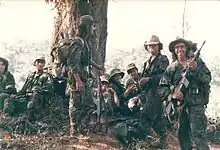
In 1961, Carlos Fonseca looked back to the historical figure of Sandino, and along with two other people (one of whom was believed to be Casimiro Sotelo, who was later assassinated), founded the Sandinista National Liberation Front (FSLN).[56] After the 1972 earthquake and Somoza's apparent corruption, the ranks of the Sandinistas were flooded with young disaffected Nicaraguans who no longer had anything to lose.[71]
In December 1974, a group of the FSLN, in an attempt to kidnap U.S. ambassador Turner Shelton, held some Managuan partygoers hostage (after killing the host, former agriculture minister, Jose Maria Castillo), until the Somozan government met their demands for a large ransom and free transport to Cuba. Somoza granted this, then subsequently sent his national guard out into the countryside to look for the perpetrators of the kidnapping, described by opponents of the kidnapping as "terrorists".[72]
On January 10, 1978, Pedro Joaquín Chamorro Cardenal, the editor of the national newspaper La Prensa and ardent opponent of Somoza, was assassinated.[73] It is alleged that the planners and perpetrators of the murder were at the highest echelons of the Somoza regime.[73]
The Sandinistas forcefully took power in July 1979, ousting Somoza, and prompting the exodus of the majority of Nicaragua's middle class, wealthy landowners, and professionals, many of whom settled in the United States.[74][75][76] The Carter administration decided to work with the new government, while attaching a provision for aid forfeiture if it was found to be assisting insurgencies in neighboring countries.[77] Somoza fled the country and eventually ended up in Paraguay, where he was assassinated in September 1980, allegedly by members of the Argentinian Revolutionary Workers' Party.[78]
In 1980, the Carter administration provided $60 million in aid to Nicaragua under the Sandinistas, but the aid was suspended when the administration obtained evidence of Nicaraguan shipment of arms to El Salvadoran rebels.[79] In response to the coming to power of the Sandinistas, various rebel groups collectively known as the "contras" were formed to oppose the new government. The Reagan administration authorized the CIA to help the contra rebels with funding, armaments, and training.[80] The contras operated out of camps in the neighboring countries of Honduras to the north and Costa Rica to the south.[80]

They engaged in a systematic campaign of terror among the rural Nicaraguan population to disrupt the social reform projects of the Sandinistas. Several historians have criticized the contra campaign and the Reagan administration's support for it, citing the brutality and numerous human rights violations of the contras. LaRamee and Polakoff, for example, describe the destruction of health centers, schools, and cooperatives at the hands of the rebels,[81] and others have contended that murder, rape, and torture occurred on a large scale in contra-dominated areas.[82] The United States also carried out a campaign of economic sabotage, and disrupted shipping by planting underwater mines in Nicaragua's port of Corinto,[83] an action condemned by the International Court of Justice as illegal.[84] The U.S. also sought to place economic pressure on the Sandinistas, and the Reagan administration imposed a full trade embargo.[85] The Sandinistas were also accused of human rights abuses.[86][87][88]
In the Nicaraguan general elections of 1984, which were judged to have been free and fair, the Sandinistas won the parliamentary election and their leader Daniel Ortega won the presidential election.[89][90] The Reagan administration criticized the elections as a "sham" based on the charge that Arturo Cruz, the candidate nominated by the Coordinadora Democrática Nicaragüense, comprising three right wing political parties, did not participate in the elections. However, the administration privately argued against Cruz's participation for fear his involvement would legitimize the elections, and thus weaken the case for American aid to the contras.[91] According to Martin Kriele, the results of the election were rigged.[92][93][94][95]
After the U.S. Congress prohibited federal funding of the contras in 1983, the Reagan administration nonetheless illegally continued to back them by covertly selling arms to Iran and channeling the proceeds to the contras (the Iran–Contra affair), for which several members of the Reagan administration were convicted of felonies.[96] The International Court of Justice, in regard to the case of Nicaragua v. United States in 1984, found, "the United States of America was under an obligation to make reparation to the Republic of Nicaragua for all injury caused to Nicaragua by certain breaches of obligations under customary international law and treaty-law committed by the United States of America".[97] During the war between the contras and the Sandinistas, 30,000 people were killed.[98]
Post-war (1990–present)

In the Nicaraguan general election, 1990, a coalition of anti-Sandinista parties (from the left and right of the political spectrum) led by Violeta Chamorro, the widow of Pedro Joaquín Chamorro Cardenal, defeated the Sandinistas. The defeat shocked the Sandinistas, who had expected to win.[99]
Exit polls of Nicaraguans reported Chamorro's victory over Ortega was achieved with a 55% majority.[100] Chamorro was the first woman president of Nicaragua. Ortega vowed he would govern desde abajo (from below).[101] Chamorro came to office with an economy in ruins, primarily because of the financial and social costs of the contra war with the Sandinista-led government.[102] In the next election, the Nicaraguan general election, 1996, Daniel Ortega and the Sandinistas of the FSLN were defeated again, this time by Arnoldo Alemán of the Constitutional Liberal Party (PLC).

In the 2001 elections, the PLC again defeated the FSLN, with Alemán's Vice President Enrique Bolaños succeeding him as president. Subsequently, however, Alemán was convicted and sentenced in 2003 to 20 years in prison for embezzlement, money laundering, and corruption;[103] liberal and Sandinista parliament members subsequently combined to strip the presidential powers of President Bolaños and his ministers, calling for his resignation and threatening impeachment. The Sandinistas said they no longer supported Bolaños after U.S. Secretary of State Colin Powell told Bolaños to keep his distance from the FSLN.[104] This "slow motion coup d'état" was averted partially by pressure from the Central American presidents, who vowed not to recognize any movement that removed Bolaños; the U.S., the OAS, and the European Union also opposed the action.[105]
Before the general elections on November 5, 2006, the National Assembly passed a bill further restricting abortion in Nicaragua.[106] As a result, Nicaragua is one of five countries in the world where abortion is illegal with no exceptions.[107] Legislative and presidential elections took place on November 5, 2006. Ortega returned to the presidency with 37.99% of the vote. This percentage was enough to win the presidency outright, because of a change in electoral law which lowered the percentage requiring a runoff election from 45% to 35% (with a 5% margin of victory).[108] Nicaragua's 2011 general election resulted in re-election of Ortega, with a landslide victory and 62.46% of the vote. In 2014 the National Assembly approved changes to the constitution allowing Ortega to run for a third successive term.[109]
In November 2016, Ortega was elected for his third consecutive term (his fourth overall). International monitoring of the elections was initially prohibited, and as a result the validity of the elections has been disputed, but observation by the OAS was announced in October.[110][111] Ortega was reported by Nicaraguan election officials as having received 72% of the vote. However the Broad Front for Democracy (FAD), having promoted boycotts of the elections, claimed that 70% of voters had abstained (while election officials claimed 65.8% participation).[112]
In April 2018, demonstrations opposed a decree increasing taxes and reducing benefits in the country's pension system. Local independent press organizations had documented at least 19 dead and over 100 missing in the ensuing conflict.[113] A reporter from NPR spoke to protestors who explained that while the initial issue was about the pension reform, the uprisings that spread across the country reflected many grievances about the government's time in office, and that the fight is for President Ortega and his vice president wife to step down.[114] April 24, 2018 marked the day of the greatest march in opposition of the Sandinista party. On May 2, 2018, university-student leaders publicly announced that they give the government seven days to set a date and time for a dialogue that was promised to the people due to the recent events of repression. The students also scheduled another march on that same day for a peaceful protest. As of May 2018, estimates of the death toll were as high as 63, many of them student protesters, and the wounded totalled more than 400.[115] Following a working visit from May 17 to 21, the Inter-American Commission on Human Rights adopted precautionary measures aimed at protecting members of the student movement and their families after testimonies indicated the majority of them had suffered acts of violence and death threats for their participation.[116] In the last week of May, thousands who accuse Mr. Ortega and his wife of acting like dictators joined in resuming anti-government rallies after attempted peace talks have remained unresolved.[117]
Geography and climate

Nicaragua occupies a landmass of 130,967 km2 (50,567 sq mi), which makes it slightly larger than England. Nicaragua has three distinct geographical regions: the Pacific lowlands – fertile valleys which the Spanish colonists settled, the Amerrisque Mountains (North-central highlands), and the Mosquito Coast (Atlantic lowlands/Caribbean lowlands).
The low plains of the Atlantic Coast are 97 km (60 mi) wide in areas. They have long been exploited for their natural resources.
On the Pacific side of Nicaragua are the two largest fresh water lakes in Central America—Lake Managua and Lake Nicaragua. Surrounding these lakes and extending to their northwest along the rift valley of the Gulf of Fonseca are fertile lowland plains, with soil highly enriched by ash from nearby volcanoes of the central highlands. Nicaragua's abundance of biologically significant and unique ecosystems contribute to Mesoamerica's designation as a biodiversity hotspot. Nicaragua has made efforts to become less dependent on fossil fuels, and it expects to acquire 90% of its energy from renewable resources by the year 2020.[118][119]
Nearly one fifth of Nicaragua is designated as protected areas like national parks, nature reserves, and biological reserves. The country had a 2019 Forest Landscape Integrity Index mean score of 3.63/10, ranking it 146th globally out of 172 countries.[120] Geophysically, Nicaragua is surrounded by the Caribbean Plate, an oceanic tectonic plate underlying Central America and the Cocos Plate. Since Central America is a major subduction zone, Nicaragua hosts most of the Central American Volcanic Arc.
Pacific lowlands
.jpg.webp)
In the west of the country, these lowlands consist of a broad, hot, fertile plain. Punctuating this plain are several large volcanoes of the Cordillera Los Maribios mountain range, including Mombacho just outside Granada, and Momotombo near León. The lowland area runs from the Gulf of Fonseca to Nicaragua's Pacific border with Costa Rica south of Lake Nicaragua. Lake Nicaragua is the largest freshwater lake in Central America (20th largest in the world),[121] and is home to some of the world's rare freshwater sharks (Nicaraguan shark).[122] The Pacific lowlands region is the most populous, with over half of the nation's population.
The eruptions of western Nicaragua's 40 volcanoes, many of which are still active, have sometimes devastated settlements but also have enriched the land with layers of fertile ash. The geologic activity that produces vulcanism also breeds powerful earthquakes. Tremors occur regularly throughout the Pacific zone, and earthquakes have nearly destroyed the capital city, Managua, more than once.[123]
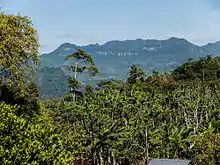
Most of the Pacific zone is tierra caliente, the "hot land" of tropical Spanish America at elevations under 610 metres (2,000 ft). Temperatures remain virtually constant throughout the year, with highs ranging between 29.4 and 32.2 °C (85 and 90 °F). After a dry season lasting from November to April, rains begin in May and continue to October, giving the Pacific lowlands 1,016 to 1,524 millimetres (40 to 60 in) of precipitation. Good soils and a favourable climate combine to make western Nicaragua the country's economic and demographic centre. The southwestern shore of Lake Nicaragua lies within 24 kilometres (15 mi) of the Pacific Ocean. Thus the lake and the San Juan River were often proposed in the 19th century as the longest part of a canal route across the Central American isthmus. Canal proposals were periodically revived in the 20th and 21st centuries.[123][124] Roughly a century after the opening of the Panama Canal, the prospect of a Nicaraguan ecocanal remains a topic of interest.[125][126][127][128]
In addition to its beach and resort communities, the Pacific lowlands contains most of Nicaragua's Spanish colonial architecture and artifacts. Cities such as León and Granada abound in colonial architecture; founded in 1524, Granada is the oldest colonial city in the Americas.[129]
North central highlands
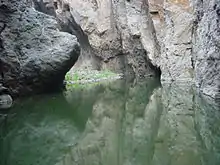
Northern Nicaragua is the most diversified region producing coffee, cattle, milk products, vegetables, wood, gold, and flowers. Its extensive forests, rivers and geography are suited for ecotourism.
The central highlands are a significantly less populated and economically developed area in the north, between Lake Nicaragua and the Caribbean. Forming the country's tierra templada, or "temperate land", at elevations between 610 and 1,524 metres (2,000 and 5,000 ft), the highlands enjoy mild temperatures with daily highs of 23.9 to 26.7 °C (75 to 80 °F). This region has a longer, wetter rainy season than the Pacific lowlands, making erosion a problem on its steep slopes. Rugged terrain, poor soils, and low population density characterize the area as a whole, but the northwestern valleys are fertile and well settled.[123]
The area has a cooler climate than the Pacific lowlands. About a quarter of the country's agriculture takes place in this region, with coffee grown on the higher slopes. Oaks, pines, moss, ferns and orchids are abundant in the cloud forests of the region.
Bird life in the forests of the central region includes resplendent quetzals, goldfinches, hummingbirds, jays and toucanets.
Caribbean lowlands
This large rainforest region is irrigated by several large rivers and is sparsely populated. The area has 57% of the territory of the nation and most of its mineral resources. It has been heavily exploited, but much natural diversity remains. The Rio Coco is the largest river in Central America; it forms the border with Honduras. The Caribbean coastline is much more sinuous than its generally straight Pacific counterpart; lagoons and deltas make it very irregular.
Nicaragua's Bosawás Biosphere Reserve is in the Atlantic lowlands, part of which is located in the municipality of Siuna; it protects 7,300 square kilometres (1,800,000 acres) of La Mosquitia forest – almost 7% of the country's area – making it the largest rainforest north of the Amazon in Brazil.[130]
The municipalities of Siuna, Rosita, and Bonanza, known as the "Mining Triangle", are located in the region known as the RAAN, in the Caribbean lowlands. Bonanza still contains an active gold mine owned by HEMCO. Siuna and Rosita do not have active mines but panning for gold is still very common in the region.
Nicaragua's tropical east coast is very different from the rest of the country. The climate is predominantly tropical, with high temperature and high humidity. Around the area's principal city of Bluefields, English is widely spoken along with the official Spanish. The population more closely resembles that found in many typical Caribbean ports than the rest of Nicaragua.[131]
A great variety of birds can be observed including eagles, toucans, parakeets and macaws. Other animal life in the area includes different species of monkeys, anteaters, white-tailed deer and tapirs.[132]
Nature and environment
Flora and fauna
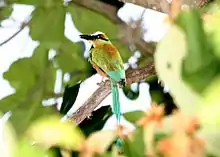
Nicaragua is home to a rich variety of plants and animals. Nicaragua is located in the middle of the Americas and this privileged location has enabled the country to serve as host to a great biodiversity. This factor, along with the weather and light altitudinal variations, allows the country to harbor 248 species of amphibians and reptiles, 183 species of mammals, 705 bird species, 640 fish species, and about 5,796 species of plants.
The region of great forests is located on the eastern side of the country. Rainforests are found in the Río San Juan Department and in the autonomous regions of RAAN and RAAS. This biome groups together the greatest biodiversity in the country and is largely protected by the Indio Maíz Biological Reserve in the south and the Bosawás Biosphere Reserve in the north. The Nicaraguan jungles, which represent about 9,700 square kilometres (2.4 million acres), are considered the lungs of Central America and comprise the second largest-sized rainforest of the Americas.[133][134]
There are currently 78 protected areas in Nicaragua, covering more than 22,000 square kilometres (8,500 sq mi), or about 17% of its landmass. These include wildlife refuges and nature reserves that shelter a wide range of ecosystems. There are more than 1,400 animal species classified thus far in Nicaragua. Some 12,000 species of plants have been classified thus far in Nicaragua, with an estimated 5,000 species not yet classified.[135]
The bull shark is a species of shark that can survive for an extended period of time in fresh water. It can be found in Lake Nicaragua and the San Juan River, where it is often referred to as the "Nicaragua shark".[136] Nicaragua has recently banned freshwater fishing of the Nicaragua shark and the sawfish in response to the declining populations of these animals.[137]
Climate change
Nicaragua was one of the few countries that did not enter an INDC at COP21.[138][139] Nicaragua initially chose not to join the Paris Climate Accord because it felt that "much more action is required" by individual countries on restricting global temperature rise.[118] However, in October 2017, Nicaragua made the decision to join the agreement.[140][141][142] It ratified this agreement on November 22, 2017.[143]
Government

Politics of Nicaragua takes place in a framework of a presidential representative democratic republic, whereby the President of Nicaragua is both head of state and head of government, and of a multi-party system. Executive power is exercised by the government. Legislative power is vested in both the government and the national assembly. The judiciary is independent of the executive and the legislature.
Between 2007 and 2009, Nicaragua's major political parties discussed the possibility of going from a presidential system to a parliamentary system. Their reason: there would be a clear differentiation between the head of government (prime minister) and the head of state (president). Nevertheless, it was later argued that the true reason behind this proposal was to find a legal way for President Ortega to stay in power after January 2012, when his second and last government period was expected to end. Ortega was reelected to a third term in November 2016.
Foreign relations
Nicaragua pursues an independent foreign policy. Nicaragua is in territorial disputes with Colombia over the Archipelago de San Andrés y Providencia and Quita Sueño Bank and with Costa Rica over a boundary dispute involving the San Juan River.
The International Court of Justice, in regard to the case of Nicaragua v. United States in 1984, found that the United States was "in breach of its obligations under customary international law not to use force against another State", "not to intervene in its affairs", "not to violate its sovereignty", "not to interrupt peaceful maritime commerce".[97]
Military

The armed forces of Nicaragua consists of various military contingents. Nicaragua has an army, navy and an air force. There are roughly 14,000 active duty personnel, which is much less compared to the numbers seen during the Nicaraguan Revolution. Although the army has had a rough military history, a portion of its forces, which were known as the national guard, became integrated with what is now the National Police of Nicaragua. In essence, the police became a gendarmerie. The National Police of Nicaragua are rarely, if ever, labeled as a gendarmerie. The other elements and manpower that were not devoted to the national police were sent over to cultivate the new Army of Nicaragua.
The age to serve in the armed forces is 17 and conscription is not imminent. As of 2006, the military budget was roughly 0.7% of Nicaragua's expenditures.
In 2017, Nicaragua signed the UN treaty on the Prohibition of Nuclear Weapons.[144]
Law enforcement
The National Police of Nicaragua Force (in Spanish: La Policía Nacional Nicaragüense) is the national police of Nicaragua. The force is in charge of regular police functions and, at times, works in conjunction with the Nicaraguan military, making it an indirect and rather subtle version of a gendarmerie. However, the Nicaraguan National Police work separately and have a different established set of norms than the nation's military. According to a recent US Department of State report, corruption is endemic, especially within law enforcement and the judiciary, and arbitrary arrests, torture, and harsh prison conditions are the norm.[145]
Nicaragua is the safest country in Central America and one of the safest in Latin America, according to the United Nations Development Program, with a homicide rate of 8.7 per 100,000 inhabitants.[146]
Administrative divisions
Nicaragua is a unitary republic. For administrative purposes it is divided into 15 departments (departamentos) and two self-governing regions (autonomous communities) based on the Spanish model. The departments are then subdivided into 153 municipios (municipalities). The two autonomous regions are the North Caribbean Coast Autonomous Region and South Caribbean Coast Autonomous Region, often referred to as RACCN and RACCS, respectively.[147]
|
Economy

Nicaragua is among the poorest countries in the Americas.[148][149][150] Its gross domestic product (GDP) in purchasing power parity (PPP) in 2008 was estimated at US$17.37 billion.[5] Agriculture represents 15.5% of GDP, the highest percentage in Central America.[151] Remittances account for over 15% of the Nicaraguan GDP. Close to one billion dollars are sent to the country by Nicaraguans living abroad.[152] The economy grew at a rate of about 4% in 2011.[5] By 2019, given restrictive taxes and a civil conflict, it recorded a negative growth of - 3.9%; the International Monetary Fund forecast for 2020 is a further decline of 6% due to COVID-19.[153]
The restrictive tax measures put in place in 2019 and a political crisis over social security negatively affected the country's weak public spending and investor confidence in sovereign debt. According to the update IMF forecasts from 14 April 2020, due to the outbreak of the COVID-19, GDP growth is expected to fall to -6% in 2020.
According to the United Nations Development Programme, 48% of the population of Nicaragua live below the poverty line,[154] 79.9% of the population live with less than $2 per day,[155] According to UN figures, 80% of the indigenous people (who make up 5% of the population) live on less than $1 per day.[156]
According to the World Bank, Nicaragua ranked as the 123rd out of 190 best economy for starting a business.[157] In 2007, Nicaragua's economy was labelled "62.7% free" by the Heritage Foundation, with high levels of fiscal, government, labor, investment, financial, and trade freedom.[158] It ranked as the 61st freest economy, and 14th (of 29) in the Americas.
In March 2007, Poland and Nicaragua signed an agreement to write off 30.6 million dollars which was borrowed by the Nicaraguan government in the 1980s.[159] Inflation reduced from 33,500% in 1988 to 9.45% in 2006, and the foreign debt was cut in half.[160]
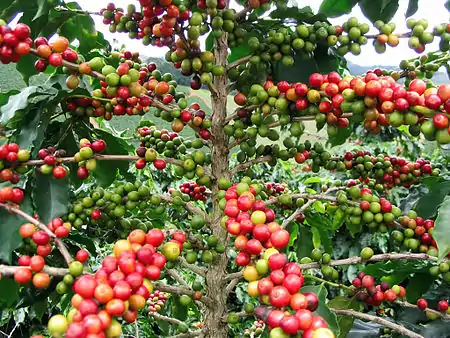
Nicaragua is primarily an agricultural country; agriculture constitutes 60% of its total exports which annually yield approximately US$300 million.[161] Nearly two-thirds of the coffee crop comes from the northern part of the central highlands, in the area north and east of the town of Estelí.[123] Tobacco, grown in the same northern highlands region as coffee, has become an increasingly important cash crop since the 1990s, with annual exports of leaf and cigars in the neighborhood of $200 million per year.[162] Soil erosion and pollution from the heavy use of pesticides have become serious concerns in the cotton district. Yields and exports have both been declining since 1985.[123] Today most of Nicaragua's bananas are grown in the northwestern part of the country near the port of Corinto; sugarcane is also grown in the same district.[123] Cassava, a root crop somewhat similar to the potato, is an important food in tropical regions. Cassava is also the main ingredient in tapioca pudding.[123] Nicaragua's agricultural sector has benefited because of the country's strong ties to Venezuela. It is estimated that Venezuela will import approximately $200 million in agricultural goods.[163] In the 1990s, the government initiated efforts to diversify agriculture. Some of the new export-oriented crops were peanuts, sesame, melons, and onions.[123]
Fishing boats on the Caribbean side bring shrimp as well as lobsters into processing plants at Puerto Cabezas, Bluefields, and Laguna de Perlas.[123] A turtle fishery thrived on the Caribbean coast before it collapsed from overexploitation.[123]
Mining is becoming a major industry in Nicaragua,[164] contributing less than 1% of gross domestic product (GDP). Restrictions are being placed on lumbering due to increased environmental concerns about destruction of the rain forests. But lumbering continues despite these obstacles; indeed, a single hardwood tree may be worth thousands of dollars.[123]
During the war between the US-backed Contras and the government of the Sandinistas in the 1980s, much of the country's infrastructure was damaged or destroyed.[165] Transportation throughout the nation is often inadequate. For example, it was until recently impossible to travel all the way by highway from Managua to the Caribbean coast. A new road between Nueva Guinea and Bluefields is almost complete (February 2019), and already allows a regular bus service to the capital.[123] The Centroamérica power plant on the Tuma River in the Central highlands has been expanded, and other hydroelectric projects have been undertaken to help provide electricity to the nation's newer industries.[123] Nicaragua has long been considered as a possible site for a new sea-level canal that could supplement the Panama Canal.[123]
Nicaragua's minimum wage is among the lowest in the Americas and in the world.[166][167][168][169] Remittances are equivalent to roughly 15% of the country's gross domestic product.[5] Growth in the maquila sector slowed in the first decade of the 21st century with rising competition from Asian markets, particularly China.[123] Land is the traditional basis of wealth in Nicaragua, with great fortunes coming from the export of staples such as coffee, cotton, beef, and sugar. Almost all of the upper class and nearly a quarter of the middle class are substantial landowners.
A 1985 government study classified 69.4 percent of the population as poor on the basis that they were unable to satisfy one or more of their basic needs in housing, sanitary services (water, sewage, and garbage collection), education, and employment. The defining standards for this study were very low; housing was considered substandard if it was constructed of discarded materials with dirt floors or if it was occupied by more than four persons per room.
Rural workers are dependent on agricultural wage labor, especially in coffee and cotton. Only a small fraction hold permanent jobs. Most are migrants who follow crops during the harvest period and find other work during the off-season. The "lower" peasants are typically smallholders without sufficient land to sustain a family; they also join the harvest labor force. The "upper" peasants have sufficient resources to be economically independent. They produce enough surplus, beyond their personal needs, to allow them to participate in the national and world markets.
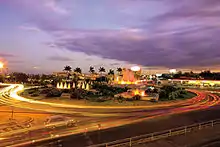
The urban lower class is characterized by the informal sector of the economy. The informal sector consists of small-scale enterprises that utilize traditional technologies and operate outside the legal regime of labor protections and taxation. Workers in the informal sector are self-employed, unsalaried family workers or employees of small-enterprises, and they are generally poor.
Nicaragua's informal sector workers include tinsmiths, mattress makers, seamstresses, bakers, shoemakers, and carpenters; people who take in laundry and ironing or prepare food for sale in the streets; and thousands of peddlers, owners of small businesses (often operating out of their own homes), and market stall operators. Some work alone, but others labor in the small talleres (workshops/factories) that are responsible for a large share of the country's industrial production. Because informal sector earnings are generally very low, few families can subsist on one income.[170] Like most Latin American nations Nicaragua is also characterized by a very small upper-class, roughly 2% of the population, that is very wealthy and wields the political and economic power in the country that is not in the hands of foreign corporations and private industries. These families are oligarchical in nature and have ruled Nicaragua for generations and their wealth is politically and economically horizontally and vertically integrated.
Nicaragua is currently a member of the Bolivarian Alliance for the Americas, which is also known as ALBA. ALBA has proposed creating a new currency, the Sucre, for use among its members. In essence, this means that the Nicaraguan córdoba will be replaced with the Sucre. Other nations that will follow a similar pattern include: Venezuela, Ecuador, Bolivia, Honduras, Cuba, Saint Vincent and the Grenadines, Dominica and Antigua and Barbuda.[171]
Nicaragua is considering construction of a canal linking the Atlantic to the Pacific Ocean, which President Daniel Ortega has said will give Nicaragua its "economic independence."[172] Scientists have raised concerns about environmental impacts, but the government has maintained that the canal will benefit the country by creating new jobs and potentially increasing its annual growth to an average of 8% per year.[173] The project was scheduled to begin construction in December 2014,[174] however the Nicaragua Canal has yet to be started.[175]
Tourism
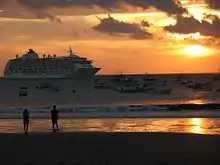
By 2006, tourism had become the second largest industry in Nicaragua.[176] Previously, tourism had grown about 70% nationwide during a period of 7 years, with rates of 10%–16% annually.[177] The increase and growth led to the income from tourism to rise more than 300% over a period of 10 years.[178] The growth in tourism has also positively affected the agricultural, commercial, and finance industries, as well as the construction industry. President Daniel Ortega has stated his intention to use tourism to combat poverty throughout the country.[179] The results for Nicaragua's tourism-driven economy have been significant, with the nation welcoming one million tourists in a calendar year for the first time in its history in 2010.[180]

Every year about 60,000 U.S. citizens visit Nicaragua, primarily business people, tourists, and those visiting relatives.[181] Some 5,300 people from the U.S. reside in Nicaragua. The majority of tourists who visit Nicaragua are from the U.S., Central or South America, and Europe. According to the Ministry of Tourism of Nicaragua (INTUR),[182] the colonial cities of León and Granada are the preferred spots for tourists. Also, the cities of Masaya, Rivas and the likes of San Juan del Sur, El Ostional, the Fortress of the Immaculate Conception, Ometepe Island, the Mombacho volcano, and the Corn Islands among other locations are the main tourist attractions. In addition, ecotourism, sport fishing and surfing attract many tourists to Nicaragua.
According to the TV Noticias news program, the main attractions in Nicaragua for tourists are the beaches, the scenic routes, the architecture of cities such as León and Granada, ecotourism, and agritourism particularly in northern Nicaragua.[177] As a result of increased tourism, Nicaragua has seen its foreign direct investment increase by 79.1% from 2007 to 2009.[183]
Nicaragua is referred to as "the land of lakes and volcanoes" due to the number of lagoons and lakes, and the chain of volcanoes that runs from the north to the south along the country's Pacific side.[11][12][184] Today, only 7 of the 50 volcanoes in Nicaragua are considered active. Many of these volcanoes offer some great possibilities for tourists with activities such as hiking, climbing, camping, and swimming in crater lakes.
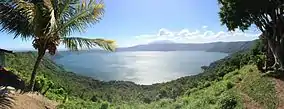
The Apoyo Lagoon Natural Reserve was created by the eruption of the Apoyo Volcano about 23,000 years ago, which left a huge 7 km-wide crater that gradually filled with water. It is surrounded by the old crater wall.[185] The rim of the lagoon is lined with restaurants, many of which have kayaks available. Besides exploring the forest around it, many water sports are practiced in the lagoon, most notably kayaking.[186]
Sand skiing has become a popular attraction at the Cerro Negro volcano in León. Both dormant and active volcanoes can be climbed. Some of the most visited volcanoes include the Masaya Volcano, Momotombo, Mombacho, Cosigüina and Ometepe's Maderas and Concepción.

Ecotourism aims to be ecologically and socially conscious; it focuses on local culture, wilderness, and adventure. Nicaragua's ecotourism is growing with every passing year.[187] It boasts a number of ecotourist tours and perfect places for adventurers. Nicaragua has three eco-regions (the Pacific, Central, and Atlantic) which contain volcanoes, tropical rainforests, and agricultural land.[188] The majority of the eco-lodges and other environmentally-focused touristic destinations are found on Ometepe Island,[189] located in the middle of Lake Nicaragua just an hour's boat ride from Granada. While some are foreign-owned, others are owned by local families.
Demographics

| Population[190][191] | |||
|---|---|---|---|
| Year | Million | ||
| 1950 | 1.3 | ||
| 2000 | 5.0 | ||
| 2018 | 6.5 | ||
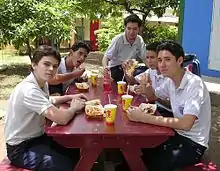
According to a 2014 research published in the journal Genetics and Molecular Biology, European ancestry predominates in 69% of Nicaraguans, followed by African ancestry in 20%, and lastly indigenous ancestry in 11%.[192] A Japanese research of "Genomic Components in America's demography" demonstrated that, on average, the ancestry of Nicaraguans is 58–62% European, 28% Native American, and 14% African, with a very small Near Eastern contribution.[193] Non-genetic data from the CIA World Factbook establish that from Nicaragua's 2016 population of 5,966,798, around 69% are mestizo, 17% white, 5% Native American, and 9% black and other races.[5] This fluctuates with changes in migration patterns. The population is 58% urban as of 2013.[194]
The capital Managua is the biggest city, with an estimated population of 1,042,641 in 2016.[195] In 2005, over 5 million people lived in the Pacific, Central and North regions, and 700,000 in the Caribbean region.[196]
There is a growing expatriate community,[197] the majority of whom move for business, investment or retirement from across the world, such as from the US, Canada, Taiwan, and European countries; the majority have settled in Managua, Granada and San Juan del Sur.
Many Nicaraguans live abroad, particularly in Costa Rica, the United States, Spain, Canada, and other Central American countries.[198]
Nicaragua has a population growth rate of 1.5% as of 2013.[199] This is the result of one of the highest birth rates in the Western Hemisphere: 17.7 per 1,000 as of 2017.[200] The death rate was 4.7 per 1,000 during the same period according to the United Nations.[201]
Ethnic groups
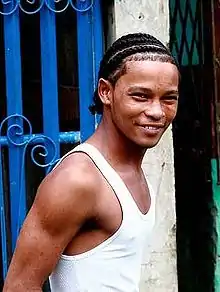
The majority of the Nicaraguan population is composed of mestizos, roughly 69%. 17% of Nicaragua's population is of unmixed European stock, with the majority of them being of Spanish descent, while others are of German, Italian, English, Turkish, Danish or French ancestry.
Black Creoles
About 9% of Nicaragua's population is black and mainly resides on the country's Caribbean (or Atlantic) coast. The black population is mostly composed of black English-speaking Creoles who are the descendants of escaped or shipwrecked slaves; many carry the name of Scottish settlers who brought slaves with them, such as Campbell, Gordon, Downs, and Hodgeson. Although many Creoles supported Somoza because of his close association with the US, they rallied to the Sandinista cause in July 1979 only to reject the revolution soon afterwards in response to a new phase of 'westernization' and imposition of central rule from Managua.[202] There is a smaller number of Garifuna, a people of mixed West African, Carib and Arawak descent. In the mid-1980s, the government divided the Zelaya Department – consisting of the eastern half of the country – into two autonomous regions and granted the black and indigenous people of this region limited self-rule within the republic.
Indigenous population
The remaining 5% of Nicaraguans are indigenous, the descendants of the country's original inhabitants. Nicaragua's pre-Columbian population consisted of many indigenous groups. In the western region, the Nahua (Pipil-Nicarao) people were present along with other groups such as the Chorotega people and the Subtiabas (also known as Maribios or Hokan Xiu). The central region and the Caribbean coast of Nicaragua were inhabited by indigenous peoples who were Macro-Chibchan language groups that had migrated to and from South America in ancient times, primarily what is now Colombia and Venezuela. These groups include the present-day Matagalpas, Miskitos, Ramas, as well as Mayangnas and Ulwas who are also known as Sumos.[24]:20 In the 19th century, there was a substantial indigenous minority, but this group was largely assimilated culturally into the mestizo majority.
Languages
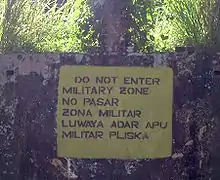
Nicaraguan Spanish has many indigenous influences and several distinguishing characteristics. For example, some Nicaraguans have a tendency to replace /s/ with /h/ when speaking.[203] Although Spanish is spoken throughout, the country has great variety: vocabulary, accents and colloquial language can vary between towns and departments.[204]
On the Caribbean coast, indigenous languages, English-based creoles, and Spanish are spoken. The Miskito language, spoken by the Miskito people as a first language and some other indigenous and Afro-descendants people as a second, third, or fourth language, is the most commonly spoken indigenous language. The indigenous Misumalpan languages of Mayangna and Ulwa are spoken by the respective peoples of the same names. Many Miskito, Mayangna, and Ulwa people also speak Miskito Coast Creole, and a large majority also speak Spanish. Fewer than three dozen of nearly 2,000 Rama people speak their Chibchan language fluently, with nearly all Ramas speaking Rama Cay Creole and the vast majority speaking Spanish. Linguists have attempted to document and revitalize the language over the past three decades.[205]
The Garifuna people, descendants of indigenous and Afro-descendant people who came to Nicaragua from Honduras in the early twentieth century, have recently attempted to revitalize their Arawakan language. The majority speak Miskito Coast Creole as their first language and Spanish as their second. The Creole or Kriol people, descendants of enslaved Africans brought to the Mosquito Coast during the British colonial period and European, Chinese, Arab, and British West Indian immigrants, also speak Miskito Coast Creole as their first language and Spanish as their second.[206]
Largest cities
Religion
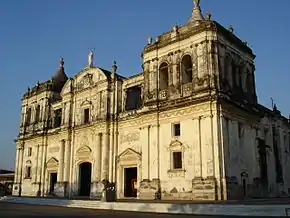
Religion plays a significant part of the culture of Nicaragua and is afforded special protections in the constitution. Religious freedom, which has been guaranteed since 1939, and religious tolerance are promoted by the government and the constitution.
Nicaragua has no official religion. Catholic bishops are expected to lend their authority to important state occasions, and their pronouncements on national issues are closely followed. They can be called upon to mediate between contending parties at moments of political crisis.[207] In 1979, Miguel D'Escoto Brockman, a priest who had embraced Liberation Theology, served in the government as foreign minister when the Sandinistas came to power. The largest denomination, and traditionally the religion of the majority, is the Roman Catholic Church. It came to Nicaragua in the 16th century with the Spanish conquest and remained, until 1939, the established faith.
The number of practicing Roman Catholics has been declining, while membership of evangelical Protestant groups and The Church of Jesus Christ of Latter-day Saints (LDS Church) has been growing rapidly since the 1990s. There is a significant LDS missionary effort in Nicaragua. There are two missions and 95,768 members of the LDS Church (1.54% of the population).[208] There are also strong Anglican and Moravian communities on the Caribbean coast in what once constituted the sparsely populated Mosquito Coast colony. It was under British influence for nearly three centuries. Protestantism was brought to the Mosquito Coast mainly by British and German colonists in forms of Anglicanism and the Moravian Church. Other kinds of Protestant and other Christian denominations were introduced to the rest of Nicaragua during the 19th century.
Popular religion revolves around the saints, who are perceived as intercessors between human beings and God. Most localities, from the capital of Managua to small rural communities, honour patron saints, selected from the Roman Catholic calendar, with annual fiestas. In many communities, a rich lore has grown up around the celebrations of patron saints, such as Managua's Saint Dominic (Santo Domingo), honoured in August with two colourful, often riotous, day-long processions through the city. The high point of Nicaragua's religious calendar for the masses is neither Christmas nor Easter, but La Purísima, a week of festivities in early December dedicated to the Immaculate Conception, during which elaborate altars to the Virgin Mary are constructed in homes and workplaces.[207]
Buddhism has increased with a steady influx of immigration.[209]
Immigration
Relative to its population, Nicaragua has not experienced large waves of immigration. The number of immigrants in Nicaragua, from other Latin American countries or other countries, never surpassed 1% of its total population before 1995. The 2005 census showed the foreign-born population at 1.2%, having risen a mere .06% in 10 years.[196]
In the 19th century, Nicaragua experienced modest waves of immigration from Europe. In particular, families from Germany, Italy, Spain, France and Belgium immigrated to Nicaragua, particularly the departments in the Central and Pacific region.
Also present is a small Middle Eastern-Nicaraguan community of Syrians, Armenians, Jewish Nicaraguans, and Lebanese people in Nicaragua. This community numbers about 30,000. There is an East Asian community mostly consisting of Chinese, Taiwanese, and Japanese. The Chinese Nicaraguan population is estimated at around 12,000.[210] The Chinese arrived in the late 19th century but were unsubstantiated until the 1920s.
Diaspora
The Civil War forced many Nicaraguans to start lives outside of their country. Many people emigrated during the 1990s and the first decade of the 21st century due to the lack of employment opportunities and poverty. The majority of the Nicaraguan Diaspora migrated to the United States and Costa Rica. Today one in six Nicaraguans live in these two countries.[211]
The diaspora has seen Nicaraguans settling around in smaller communities in other parts of the world, particularly Western Europe. Small communities of Nicaraguans are found in France, Germany, Italy, Spain, Norway, Sweden and the United Kingdom. Communities also exist in Australia and New Zealand. Canada, Brazil and Argentina host small groups of these communities. In Asia, Japan hosts a small Nicaraguan community.
Due to extreme poverty at home, many Nicaraguans are now living and working in neighboring El Salvador, a country that has the US dollar as currency.[212][213]
Healthcare
Although Nicaragua's health outcomes have improved over the past few decades with the efficient utilization of resources relative to other Central American nations, healthcare in Nicaragua still confronts challenges responding to its populations' diverse healthcare needs.[214]
The Nicaraguan government guarantees universal free health care for its citizens.[215] However, limitations of current delivery models and unequal distribution of resources and medical personnel contribute to the persistent lack of quality care in more remote areas of Nicaragua, especially among rural communities in the Central and Atlantic region.[214] To respond to the dynamic needs of localities, the government has adopted a decentralized model that emphasizes community-based preventive and primary medical care.[216]
Education
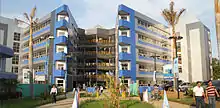
The adult literacy rate in 2005 was 78.0%.[217]
Primary education is free in Nicaragua. A system of private schools exists, many of which are religiously affiliated and often have more robust English programs.[218] As of 1979, the educational system was one of the poorest in Latin America.[219] One of the first acts of the newly elected Sandinista government in 1980 was an extensive and successful literacy campaign, using secondary school students, university students and teachers as volunteer teachers: it reduced the overall illiteracy rate from 50.3% to 12.9% within only five months.[220] This was one of a number of large-scale programs which received international recognition for their gains in literacy, health care, education, childcare, unions, and land reform.[221][222] The Sandinistas also added a leftist ideological content to the curriculum, which was removed after 1990.[123] In September 1980, UNESCO awarded Nicaragua the Soviet Union sponsored Nadezhda Krupskaya award for the literacy campaign.[223]
Gender equality
When it comes to gender equality in Latin America, Nicaragua ranks high among the other countries in the region.[224] When it came to global rankings regarding gender equality, the World Economic Forum ranked Nicaragua at number twelve in 2015,[224] and in its 2020 report Nicaragua ranked number five, behind only northern European countries.[225]
Nicaragua was among the many countries in Latin America and the Caribbean to ratify the Convention on the Elimination of All Forms of Discrimination against Women, which aimed to promote women's rights.[226]
In 2009, a Special Ombudsman for Sexual Diversity position was created within its Office of the Human Rights Ombudsman. And, in 2014, the Health Ministry in 2014 banned discrimination based on gender identity and sexual orientation.[227] Nevertheless, discrimination against LGBTQ individuals is common, particularly in housing, education, and the workplace.[145]
The Human Development Report ranked Nicaragua 106 out of 160 countries in the Gender Inequality Index (GII) in 2017. It reflects gender-based inequalities in three dimensions - reproductive health, empowerment, and economic activity.[228]
Culture
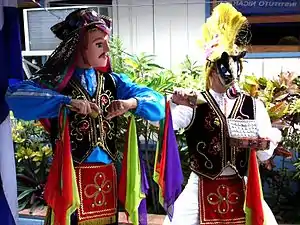
Nicaraguan culture has strong folklore, music and religious traditions, deeply influenced by European culture but also including Native American sounds and flavors. Nicaraguan culture can further be defined in several distinct strands. The Pacific coast has strong folklore, music and religious traditions, deeply influenced by Europeans. It was colonized by Spain and has a similar culture to other Spanish-speaking Latin American countries. The indigenous groups that historically inhabited the Pacific coast have largely been assimilated into the mestizo culture.
The Caribbean coast of Nicaragua was once a British protectorate. English is still predominant in this region and spoken domestically along with Spanish and indigenous languages. Its culture is similar to that of Caribbean nations that were or are British possessions, such as Jamaica, Belize, the Cayman Islands, etc. Unlike on the west coast, the indigenous peoples of the Caribbean coast have maintained distinct identities, and some still speak their native languages as first languages.
Music
Nicaraguan music is a mixture of indigenous and Spanish influences. Musical instruments include the marimba and others common across Central America. The marimba of Nicaragua is played by a sitting performer holding the instrument on his knees. He is usually accompanied by a bass fiddle, guitar and guitarrilla (a small guitar like a mandolin). This music is played at social functions as a sort of background music.
The marimba is made with hardwood plates placed over bamboo or metal tubes of varying lengths. It is played with two or four hammers. The Caribbean coast of Nicaragua is known for a lively, sensual form of dance music called Palo de Mayo which is popular throughout the country. It is especially loud and celebrated during the Palo de Mayo festival in May. The Garifuna community (Afro-Native American) is known for its popular music called Punta.
Nicaragua enjoys a variety of international influence in the music arena. Bachata, Merengue, Salsa and Cumbia have gained prominence in cultural centres such as Managua, Leon and Granada. Cumbia dancing has grown popular with the introduction of Nicaraguan artists, including Gustavo Leyton, on Ometepe Island and in Managua. Salsa dancing has become extremely popular in Managua's nightclubs. With various influences, the form of salsa dancing varies in Nicaragua. New York style and Cuban Salsa (Salsa Casino) elements have gained popularity across the country.
Dance
Dance in Nicaragua varies depending upon the region. Rural areas tend to have a stronger focus on movement of the hips and turns. The dance style in cities focuses primarily on more sophisticated footwork in addition to movement and turns. Combinations of styles from the Dominican Republic and the United States can be found throughout Nicaragua. Bachata dancing is popular in Nicaragua. A considerable amount of Bachata dancing influence comes from Nicaraguans living abroad, in cities that include Miami, Los Angeles and, to a much lesser extent, New York City. Tango has also surfaced recently in cultural cities and ballroom dance occasions.
Literature
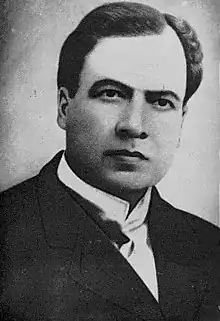
The origin of Nicaraguan literature can arguably be traced to pre-Columbian times. The myths and oral literature formed the cosmogenic view of the world of the indigenous people. Some of these stories are still known in Nicaragua. Like many Latin American countries, the Spanish conquerors have had the most effect on both the culture and the literature. Nicaraguan literature has historically been an important source of poetry in the Spanish-speaking world, with internationally renowned contributors such as Rubén Darío who is regarded as the most important literary figure in Nicaragua. He is called the "Father of Modernism" for leading the modernismo literary movement at the end of the 19th century.[230] Other literary figures include Carlos Martinez Rivas, Pablo Antonio Cuadra, Alberto Cuadra Mejia, Manolo Cuadra, Pablo Alberto Cuadra Arguello, Orlando Cuadra Downing, Alfredo Alegría Rosales, Sergio Ramirez Mercado, Ernesto Cardenal, Gioconda Belli, Claribel Alegría and José Coronel Urtecho, among others.[231]
The satirical drama El Güegüense was the first literary work of post-Columbian Nicaragua. Written in both Aztec Nahuatl and Spanish it is regarded as one of Latin America's most distinctive colonial-era expressions and as Nicaragua's signature folkloric masterpiece, a work of resistance to Spanish colonialism that combined music, dance and theatre.[230] The theatrical play was written by an anonymous author in the 16th century, making it one of the oldest indigenous theatrical/dance works of the Western Hemisphere. In 2005 it was recognized by UNESCO as "a patrimony of humanity".[232] After centuries of popular performance, the play was first published in a book in 1942.[233]
Cuisine

Nicaraguan cuisine is a mixture of Spanish food and dishes of a pre-Columbian origin.[234] Traditional cuisine changes from the Pacific to the Caribbean coast. The Pacific coast's main staple revolves around local fruits and corn, the Caribbean coast cuisine makes use of seafood and the coconut.
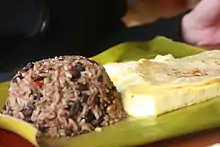
As in many other Latin American countries, maize is a staple food and is used in many of the widely consumed dishes, such as the nacatamal, and indio viejo. Maize is also an ingredient for drinks such as pinolillo and chicha as well as sweets and desserts. In addition to corn, rice and beans are eaten very often.
Gallo pinto, Nicaragua's national dish, is made with white rice and red beans that are cooked individually and then fried together. The dish has several variations including the addition of coconut milk and/or grated coconut on the Caribbean coast. Most Nicaraguans begin their day with gallo pinto. Gallo pinto is most usually served with carne asada, a salad, fried cheese, plantains or maduros.
Many of Nicaragua's dishes include indigenous fruits and vegetables such as jocote, mango, papaya, tamarindo, pipian, banana, avocado, yuca, and herbs such as cilantro, oregano and achiote.[234]
Traditional street food snacks found in Nicaragua include "quesillo", a thick tortilla with soft cheese and cream, "tajadas", deep-fried plantain chips, "maduros", sautéed ripe plantain, and "fresco", fresh juices such as hibiscus and tamarind commonly served in a plastic bag with a straw.[235]
Nicaraguans have been known to eat guinea pigs,[236] known as cuy. Tapirs, iguanas, turtle eggs, armadillos and boas are also sometimes eaten, but because of extinction threats to these wild creatures, there are efforts to curb this custom.[234]
Media
For most Nicaraguans radio and TV are the main sources of news. There are more than 100 radio stations and several TV networks. Cable TV is available in most urban areas.[237]
The Nicaraguan print media are varied and partisan, representing pro and anti-government positions. Publications include La Prensa, El Nuevo Diario, Confidencial, Hoy, and Mercurio. Online news publications include Confidencial and The Nicaragua Dispatch.
Sports
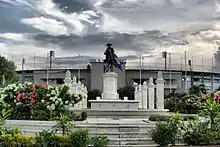
Baseball is the most popular sport in Nicaragua. Although some professional Nicaraguan baseball teams have recently folded, the country still enjoys a strong tradition of American-style baseball.
Baseball was introduced to Nicaragua during the 19th century. In the Caribbean coast, locals from Bluefields were taught how to play baseball in 1888 by Albert Addlesberg, a retailer from the United States.[238] Baseball did not catch on in the Pacific coast until 1891 when a group of mostly college students from the United States formed "La Sociedad de Recreo" (Society of Recreation) where they played various sports, baseball being the most popular.[238]
Nicaragua has had its share of MLB players, including shortstop Everth Cabrera and pitcher Vicente Padilla, but the most notable is Dennis Martínez, who was the first baseball player from Nicaragua to play in Major League Baseball.[239] He became the first Latin-born pitcher to throw a perfect game, and the 13th in the major league history, when he played with the Montreal Expos against the Dodgers at Dodger Stadium in 1991.[240]
Boxing is the second most popular sport in Nicaragua.[241] The country has had world champions such as Alexis Argüello and Ricardo Mayorga as well as Román González. Recently, football has gained popularity. The Dennis Martínez National Stadium has served as a venue for both baseball and football. The first ever national football-only stadium in Managua, the Nicaragua National Football Stadium, was completed in 2011.[242]
Nicaragua's national basketball team had some recent success as it won the silver medal at the 2017 Central American Games.[243]
References
- Banco Central de Nicaragua Archived 2010-09-24 at the Wayback Machine
- "Nicaragua Demographics Profile 2011". Nicaragua. Index Mundi. 2011. Retrieved 2011-07-16.
- The Latin American Socio-Religious Studies Program / Programa Latinoamericano de Estudios Sociorreligiosos (PROLADES) PROLADES Religion in America by country
- "CENSO DE POBLACIÓN 2005" (PDF). 2015. Retrieved 4 April 2015.
- "Nicaragua". CIA World Factbook. Retrieved 2007-05-09.
- "Nicaragua | Economic Indicators | Moody's Analytics". www.economy.com. Retrieved 2020-05-29.
- "Población Total, estimada al 30 de Junio del año 2012" (PDF) (in Spanish). National Nicaraguan Institute of Development Information. pp. 1–5. Archived from the original (PDF) on 2 May 2013. Retrieved 24 March 2013.
- "Nicaragua". International Monetary Fund.
- "GINI index (World Bank estimate)". data.worldbank.org. World Bank. Retrieved 7 March 2019.
- "Human Development Report 2019" (PDF). United Nations Development Programme. 10 December 2019. Archived from the original (PDF) on 22 March 2017. Retrieved 10 December 2019.
- Brierley, Jan (October 15, 2017). "Sense of wonder: Discover the turbulent past of Central America". Daily Express. Retrieved October 27, 2017.
- Wallace, Will; Wallace, Camilla (April 10, 2010). "Traveller's Guide: Nicaragua". The Independent. Retrieved October 27, 2017.
- Dicum, G (2006-12-17). "The Rediscovery of Nicaragua". Travel Section. New York: TraveThe New York Times. Retrieved 2010-06-26.
- Davis, LS (2009-04-22). "Nicaragua: The next Costa Rica?". Mother Nature Network. MNN Holdings, LLC. Retrieved 2010-06-26.
- "¿Por qué los países de América Latina se llaman como se llaman?" [Why do Latin American countries call themselves as they are called?]. Ideal (in Spanish). July 29, 2015. Retrieved April 12, 2017.
- Sánchez, Edwin (October 16, 2016). "El origen de "Nicarao-agua": la Traición y la Paz". El Pueblo Presidente (in Spanish). Archived from the original on 2017-08-01. Retrieved July 3, 2017.
- Sánchez, Edwin (October 3, 2016). "De Macuilmiquiztli al Güegüence pasando por Fernando Silva" [From Macuilmiquiztli to Güegüence through Fernando Silva]. El 19 (in Spanish). Retrieved April 12, 2017.
- Silva, Fernando (March 15, 2003). "Macuilmiquiztli". El Nuevo Diario (in Spanish). Retrieved April 12, 2017.
- Sánchez, Edwin (September 16, 2002). "No hubo Nicarao, todo es invento" [There was no Nicarao, it's all invented]. El Nuevo Diario (in Spanish).
- "Encuentro del cacique y el conquistador" [Encounter of the cacique and the conqueror]. El Nuevo Diario (in Spanish). April 4, 2009. Retrieved May 17, 2017.
- Torres Solórzano, Carla (September 18, 2010). "Choque de lenguas o el mestizaje de nuestro idioma" [Clash of languages or the mixing of our language]. La Prensa (in Spanish). Retrieved April 12, 2017.
- "La raíz nahuatl de nuestro lenguaje" [The Nahuatl root of our language]. El Nuevo Diario (in Spanish). August 10, 2004. Retrieved July 3, 2017.
- Dall, Christopher (October 1, 2005). Nicaragua in Pictures. Twenty-First Century Books. pp. 66–67. ISBN 978-0-8225-2671-1.
- Pérez-Brignoli, Héctor; translated by Sawrey A., Ricardo B.; Sawrey, Susana Stettri de (1989). A Brief History of Central America (2nd ed.). Berkeley: University of California Press. ISBN 978-0520060494.
- Gloria Helena Rey, "The Chibcha Culture – Forgotten, But Still Alive" Archived 2012-02-20 at the Wayback Machine, Colombia, Inter Press Service (IPS) News, 30 Nov 2007, accessed 9 Nov 2010
- "Nicaragua: VI History". Encarta. 2007-06-13.
- Newson, Linda A. (1987). Indian survival in colonial Nicaragua (1st ed.). Norman [OK]: University of Oklahoma Press. ISBN 978-0806120089.
- "Nicaragua: Precolonial Period". Library of Congress Country Studies. Retrieved 2007-06-29., interpretation of statement: "the native peoples were linguistically and culturally similar to the Aztec and the Maya"
- Campbell, Lyle (January 1, 1985). The Pipil Language of El Salvador. Walter de Gruyter. pp. 10–12. ISBN 978-3-11-088199-8.
- Fowler Jr, WR (1985). "Ethnohistoric Sources on the Pipil Nicarao: A Critical Analysis". Ethnohistory. Columbus, Ohio. 32 (1): 37–62. doi:10.2307/482092. JSTOR 482092. OCLC 62217753.
- Brinton, Daniel G. (1887). "Were the Toltecs an Historic Nationality?". Proceedings of the American Philosophical Society. 24 (126): 229–230. JSTOR 983071.
- von Humboldt, Alexander; Poynter, J. Ryan; Altamirano Rayo, Giorleny D; Kraft, Tobias (January 25, 2013). Views of the Cordilleras and Monuments of the Indigenous Peoples of the Americas: A Critical Edition. University of Chicago Press. p. 92. ISBN 978-0-226-86509-6.
- "Letter of Columbus on the Fourth Voyage". American Journey. Archived from the original on 2007-04-03. Retrieved 2007-05-09.
- "Nicaragua: History". Encyclopædia Britannica. Retrieved 2007-08-21.
- Healy, Paul; Pohl, Mary (1980). Archaeology of the Rivas Region, Nicaragua. Wilfrid Laurier Univ. Press. p. 21. ISBN 978-0-88920-094-4.
- Dyck, Erika; Fletcher, Christopher (October 6, 2015). Locating Health: Historical and Anthropological Investigations of Place and Health. Routledge. p. 107. ISBN 978-1-317-32278-8.
- "The Spanish Conquest". Library of Congress. Retrieved 2007-08-21.
- "Nicaragua Briefs: An Historic Find". Envío. Central American University – UCA. Retrieved 2007-08-21.
- Duncan, David Ewing (1995). Hernando de Soto – A Savage Quest in the Americas – Book II: Consolidation. New York: Crown Publishers.
- Whisnant, David E. (November 9, 2000). Rascally Signs in Sacred Places: The Politics of Culture in Nicaragua. Univ of North Carolina Press. pp. 30–32. ISBN 978-0-8078-6626-9.
- Bergoeing, Jean Pierre (May 18, 2015). Geomorphology of Central America: A Syngenetic Perspective. Elsevier Science. pp. 68–69. ISBN 978-0-12-803185-8.
- Smith, RS (1963). "Financing the Central American federation, 1821–1838". The Hispanic American Historical Review. 43 (4): 483–510. doi:10.2307/2509898. JSTOR 2509898.
- Cybriwsky, Roman Adrian (May 23, 2013). Capital Cities around the World: An Encyclopedia of Geography, History, and Culture. ABC-CLIO. p. 177. ISBN 978-1-61069-248-9.
- "Managua". La Prensa (in Spanish). March 9, 2006. Archived from the original on November 11, 2013. Retrieved May 24, 2017.
- "Gobernantes de Nicaragua". Ministerio de Educación. 9 December 2012. Archived from the original on 9 October 2012.
- Walker, W (1860). The War in Nicaragua. New York: S.H. Goetzel & Company.
- Juda, F (1919). "California Filibusters: A History of their Expeditions into Hispanic America (excerpt)". The Grizzly Bear. XXI (4): 3–6, 15, 19. Retrieved 2011-07-20.
- Baker, CP (2001). "The William Walker Saga". Moon Handbooks: Costa Rica (4th ed.). New York: Avalon Travel Publishing. p. 67. ISBN 978-1-56691-608-0.
- Colquhoun, AR (1895). The key of the Pacific: the Nicaragua canal. Westminster, England: Archibald Constable and Company.
- Foreign Relations of the United States. 1912. p. 1032.
- Langley, Lester D. (2002). The Banana Wars: United States Intervention in the Caribbean, 1898-1934. Wilmington: SR Books. p. 64. ISBN 978-0-8420-5047-0.
- "US violence for a century: Nicaragua: 1912–33". Socialist Worker. Retrieved 2007-08-21.
- "Bryan–Chamorro Treaty". Encyclopædia Britannica. Retrieved 2007-08-21.
- "General Augusto C. Sandino: The Constitutional War". ViaNica. Retrieved 2007-08-21.
- Vukelich, D. "A Disaster Foretold". The Advocacy Project. Archived from the original on April 3, 2007. Retrieved 2007-05-09.
- "The Somoza years". Encyclopædia Britannica. Retrieved 2007-08-21.
- "Biographical Notes". Archived from the original on December 31, 2006. Retrieved 2007-05-09.
- "History of U.S. Violence Across the Globe: Washington's War Crimes (1912–33)". 2001-12-16. Retrieved 2007-05-09.
- Solo, T (2005-10-07). "Nicaragua: From Sandino to Chavez". Dissident Voice. Retrieved 2007-05-09.
- "The Somoza Dynasty" (PDF). University of Pittsburgh. p. 1. Archived from the original (PDF) on November 10, 2006. Retrieved 2007-05-09.
- Colburn, Forrest D. (2012-03-26). "Nicaragua, Forlorn". World Policy Journal. 29 (Spring 2012): 91–100. doi:10.1177/0740277512443806. Retrieved 31 May 2012.
- Model, David (2005). Lying for Empire: How to Commit War Crimes With a Straight Face. Common Courage Press.
- Goldstein, Erik (2005) Wars and Peace Treaties: 1816 to 1991. Routledge. p. 218. ISBN 9781134899111
- "El asalto de Somoza a los alemanes" (in Spanish). 6 January 2005. Archived from the original on October 12, 2007. Retrieved 2007-07-13.
- "Charter of the United Nations and Statute of the International Court of Justice" (PDF). San Francisco: United Nations. 1945-06-26: 49. Cite journal requires
|journal=(help) - Leonard, TM (2003). "Against all odds: U.S. policy and the 1963 Central America Summit Conference". Journal of Third World Studies. p. 11. Archived from the original on 2009-06-28. Retrieved 2007-05-09.
- "Headline: Nicaragua Earthquake". Vanderbilt Television News Archive. 1972-12-16. Archived from the original on 2011-05-10. Retrieved 2007-05-24.
- "Roberto Clemente – Bio". The National Baseball Hall of Fame. Archived from the original on April 27, 2007. Retrieved 2007-05-09.
- "A Battle Ends, a War Begins". TIME. 1978-09-11. Retrieved 2007-08-21.
- Annis, B (1993). "Nicaragua: Diversification and Growth, 1945–77". The Library of Congress. Retrieved 2012-09-25.
- "The Sandinistas and the Revolution". Grinnell College. Archived from the original on 2007-02-06. Retrieved 2007-05-09.
- Constable, Pamela; Valenzuela, Arturo (1991). A Nation of Enemies: Chile Under Pinochet. p. 150. ISBN 978-0-393-30985-0.
- "History of Nicaragua: The Beginning of the End". American Nicaraguan School. Archived from the original on May 20, 2006. Retrieved 2007-08-04.
- Nordheimer, Jon (July 29, 1987). "Nicaraguan Exiles Find A Place In The Sun: Miami". The New York Times. Retrieved May 27, 2017.
- Wilkinson, Tracy (August 7, 1988). "Families Struggle to Maintain Life Style : Sandinista Rule Not Easy on Middle Class". Los Angeles Times. Retrieved May 27, 2017.
- Wicker, Tom (July 29, 1983). "In The Nation; The Sandinista Puzzle". The New York Times. Retrieved May 27, 2017.
- Pastor, Robert (2001). Exiting the Whirlpool: U.S. Foreign Policy Toward Latin America and the Caribbean. Westview Press. ISBN 978-0-8133-3811-8.
- "Timeline: Nicaragua". Stanford University. Retrieved 2007-05-09.
- U.S. HALTS ECONOMIC AID TO NICARAGUA, New York Times, 2 April 1981
- "Nicaragua: Growth of Opposition, 1981–83". Ciao Atlas. Retrieved 2007-08-21.
- LaRamee, Pierre; Polakoff, Erica (1999). The Undermining of the Sandinista Revolution. New York: Palgrave Macmillan. pp. 141–205. ISBN 9780333751992.
- Chomsky, Noam (1985). Turning the Tide. Boston, MA: South End Press.
- Truver, SC. "Mines and Underwater IEDs in U.S. Ports and Waterways..." (PDF). p. 4. Archived from the original (PDF) on 2008-04-28. Retrieved 2007-08-21.
- Summary of the Order Archived 2007-11-07 at the Wayback Machine of the International Court of Justice of 10 May 1984
- "US Policy: Economic Embargo: The War Goes On". Envío. Central American University – UCA. Retrieved 2007-08-21.
- Moore, John Norton (1987) The Secret War in Central America. University Publications of America. p. 143. ISBN 978-0890939611
- Miranda, Roger and Ratliff, William (1993) The Civil War in Nicaragua. Transaction. p. 193. ISBN 9781412819688
- "Annual Report 1992–1993". Inter-American Commission on Human Rights. 1993-03-12. Retrieved 2009-03-30.
- "1984: Sandinistas claim election victory". BBC News. November 5, 1984.
- "NICARAGUAN VOTE:'FREE, FAIR, HOTLY CONTESTED'". The New York Times. p. 30.
- Taubman, Philip (21 October 1984). "KEY AIDES DISPUTE U.S. ROLE IN NICARAGUAN VOTE". The New York Times. p. 12.
- Kriele, Martin (1986). "Power and Human Rights in Nicaragua". Nicaragua: Das blutende Herz Amerikas. Piper. pp. 56–57, 63–67.
- Leiken, Robert S. (December 5, 1985) "The Nicaraguan Tangle," New York Review of Books.
- "The Nicaraguan Tangle: Another Exchange," New York Review of Books, June 26, 1986
- Cuzan, Alfred G. (Summer 1994) Letter, Commentary, December 1985 and "The Latin American Studies Association vs. the United States," Academic Questions.
- Baker, D (2007-03-05). The United States since 1980 (The World Since 1980). Cambridge, UK: Cambridge University Press. p. 101. ISBN 978-0-521-86017-8.
- "Case concerning military and paramilitary activities in and against Nicaragua (Nicaragua v. United States of America), International Court of Justice, Order of 26 september 1991" (PDF). Archived from the original (PDF) on 24 September 2015.
- The PRIO Battle Deaths Dataset, 1946–2008, Version 3.0: Documentation of Coding Decisions by Bethany Lacina
- O'Grady, M. "Ortega's Comeback Schemes Roil Nicaragua". Retrieved 2007-05-09.
- "Was February 25 a 'triumph'? National Review v. 42". Tulane University. Archived from the original on September 1, 2006. Retrieved 2007-05-09.
- "El Sandinista Daniel Ortega se convierte de nuevo en presidente de Nicaragua". El Mundo (in Spanish). 2006-11-08. Retrieved 2007-05-09.
- Dennis, G (December 1993). "Social conditions of Nicaragua". The Library of Congress. Retrieved 2007-05-09.
- "Nicaragua: Political profile". Retrieved 2007-05-09.
- Thompson, G (2005-04-06). "U.S. fears comeback of an old foe in Nicaragua". International Herald Tribune. p. 3. Archived from the original on June 6, 2008. Retrieved 2007-05-09.
- "Nicaragua 'creeping coup' warning". BBC News. 2005-09-30. Retrieved 2007-05-09.
- Frazier, JB (2006-11-18). "Nicaraguan President Signs Abortion Ban". The Washington Post. Retrieved 2007-05-25.
- Boseley, S (2010-06-11). "Nicaragua refuses to lift abortion ban". The Guardian.
- "Bolaños Will Move To The National Assembly After All". Envío Magazine. 2006. Retrieved 2007-05-09.
- Gibney, James (2014-01-30). "Nicaragua's Revolution Heads Toward Dictatorship". Bloomberg. Retrieved 2014-02-04.
- Geoff, Thale. "As Nicaragua's Election Draws Near, Concerns Grow Over Abuse of Power". WOLA. Retrieved 13 January 2018.
- "OAS Mission in Nicaragua Recommends Integral Electoral Reform". Organization of American States. November 7, 2016. Retrieved 13 January 2018.
- "Nicaragua's Ortega re-elected president". BBC News. 2016-11-07. Retrieved 2017-09-12.
- Cerda, Arlen (2018-04-22). "Los muertos de la represión que Daniel Ortega oculta". Confidencial (in Spanish). Retrieved 2018-04-25.
- Kahn, Carrie (April 23, 2018). "Nicaragua Withdraws Social Security Changes That Sparked Unrest". NPR. Retrieved 31 May 2018.
- Garvin, Glenn (May 2, 2018). "In Nicaragua, the political battle is moving from the streets to the negotiating table". Miami Herald. Retrieved May 2, 2018.
- "CIDH condena nuevos hechos de violencia en Nicaragua". www.oas.org (in Spanish). Organization of American States. Inter-American Commission on Human Rights. 25 May 2018. Retrieved 26 May 2018.
- "Nicaraguan protesters call on Ortega to go". BBC News. BBC. 27 May 2018. Retrieved 27 May 2018.
- "Why isn't Nicaragua in the Paris agreement?". BBC News. June 3, 2017. Retrieved October 27, 2017.
- "Nicaragua: a renewable energy paradise in Central America". World Bank. October 25, 2013. Retrieved October 27, 2017.
- Grantham, H. S.; et al. (2020). "Anthropogenic modification of forests means only 40% of remaining forests have high ecosystem integrity - Supplementary Material". Nature Communications. 11 (1): 5978. doi:10.1038/s41467-020-19493-3. ISSN 2041-1723. PMC 7723057. PMID 33293507.
- "Large Lakes of the World". factmonster.com. Retrieved 2007-05-25.
- "The Nature Conservancy in Nicaragua". nature.org. Archived from the original on 2007-04-05. Retrieved 2007-05-25.
- "Nicaragua." Encyclopedia Americana. Grolier Online. (200-11-20) (subscription required)
- "TED CASE: Nicaragua Canal Proposal". american.edu. Archived from the original on 2012-01-11. Retrieved 2011-07-16.
- Muñoz, Néfer (2001). "An 'Eco-Canal' across Nicaragua". Accents. Granada, Nicaragua: Tierramérica. Archived from the original on May 10, 2011. Retrieved 2011-07-20.
- "Proyecto "Construcción del Puerto Monkey Point"". Proyectos (in Spanish). Managua: Empresa Portuaria Nacional. 2009. Archived from the original on May 11, 2011. Retrieved 2011-07-20.
- Alvarez, Gustavo (2008-02-18). "Empresas de seis países interesadas en Monkey Point". elnuevodiario.com.ni (in Spanish). Managua: El Nuevo Diario. Retrieved 2011-07-20.
- Álvarez Hidalgo, Wendy (2010-07-07). "Harán puerto Monkey Point". laprensa.co.ni (in Spanish). Managua: La Prensa. Archived from the original on 2011-08-13. Retrieved 2011-07-20.
- White, RL (2004-08-24). "Pittsburghers find once war-ravaged country is a good place to invest". Post Gazette. Retrieved 2007-05-09.
- "Bosawas Bioreserve Nicaragua". Retrieved 2007-05-25.
- Trudgill, Peter; Watts, Richard J., eds. (2002). Alternative Histories of English. Routledge. p. 35. ISBN 9780415233569.
English-speaking protestants formed the majority of the population until about 1900...indigenous anglophones still form about 85 per cent of the population, which also includes non-anglophone Black Caribs...At least at the level of arolectal Whites, the accent is rhotic though obviously Caribbean....England established a protectorate over the local Miskito Indians, who the region is named after, and the area was a British dependency from 1740 to 1786. In Nicaragua the British founded the principal Miskito coast city of Bluefields... There are about 30,000 native speakers of English in this area of Nicaragua who look to Bluefields as their centre... The English of the anglophone Corn Islands is also typically Caribbean.
- "Nicaraguan Animal Guide". Vianica. Retrieved August 17, 2018.
- Rogers, Tim (May 15, 2013). "In Latin America's Second Largest Rainforest, an Indigenous Tribe Fights for Its Land". Time. Retrieved August 3, 2017.
- Connor, Liz (November 17, 2016). "10 reasons why you should visit Nicaragua". Evening Standard. Retrieved August 3, 2017.
- "National Parks and Protected Areas of Nicaragua". Retrieved 17 February 2016.
- "Nicaragua". The Nature Conservancy. Archived from the original on 5 April 2007. Retrieved 17 February 2016.
- "Nicaragua bans freshwater shark fishing amid dwindling population numbers". UnderwaterTimes.com. Retrieved 17 February 2016.
- Nussbaum, Alex; Krukowska, Ewa; Carr, Mathew (8 December 2015). "Carbon Markets Are Making a Slow, But Steady, Comeback". Bloomberg.com. Retrieved 17 February 2016.
- "INDCs as communicated by Parties". unfccc.int.
- "Nicaragua to join Paris climate accord, leaving US and Syria isolated". The Guardian. October 23, 2017. Retrieved December 4, 2017.
- Stack, Liam (October 24, 2017). "Only U.S. and Syria Now Oppose Paris Climate Deal, as Nicaragua Joins". The New York Times. Retrieved December 4, 2017.
- Noack, Rick (October 24, 2017). "Being outside the Paris climate deal: Something now only the U.S. and Syria agree on". The Washington Post. Retrieved December 4, 2017.
- "Paris Agreement – Status of Ratification". United Nations. Retrieved 13 January 2018.
- "Chapter XXVI: Disarmament – No. 9 Treaty on the Prohibition of Nuclear Weapons". United Nations Treaty Collection. 7 July 2017.
- "Nicaragua". United States Department of State. Retrieved 2020-06-22.
- Johnson, Stephen; Kareff, Samuel and Asvapromtada, Siremorn (July 10, 2012) Nicaragua: Lessons from a Country with a Low Crime Rate. csis.org
- "Background and socio-economic context" (PDF). p. 9. Archived from the original (PDF) on October 15, 2006. Retrieved 2007-05-09.
- "Nicaragua - Country Brief". web.worldbank.org.
- "Rank Order – GDP – per capita (PPP)". CIA World Factbook. Retrieved 2007-05-09.
- "Social indicators: Per capita GDP". United Nations. Retrieved 2007-05-09.
- "Field Listing :: GDP - composition, by sector of origin — The World Factbook - Central Intelligence Agency". www.cia.gov. Retrieved 2019-05-05.
- "Migration Information Source – Remittance Trends in Central America". Migrationinformation.org. April 2006. Retrieved 2010-06-26.
- Nordea (2020). Nicaragua: Economic Outline. https://www.nordeatrade.com/en/explore-new-market/nicaragua/economy
- "Programa de las Naciones Unidas para el Desarrollo – Noticias – La pobreza se arraiga en el país". Pnud.org.ni. Archived from the original on May 11, 2011. Retrieved 2010-06-26.
- "Human Development Report 2009 – Countries' shares of total stock of migrants in Africa (%)". Hdrstats.undp.org. Archived from the original on 2009-02-21. Retrieved 2010-06-26.
- Silva, JA. "NICARAGUA: Name and Identity for Thousands of Indigenous Children". IPS. Archived from the original on September 11, 2008. Retrieved 2008-09-12.
- "Economy Rankings: Doing Business". World Bank. Retrieved 2014-01-04.
- "Index Of Economic Freedom: Nicaragua". Heritage.org. Archived from the original on 2007-10-26. Retrieved 2007-11-02.
- "Poland forgives nearly 31 million dollars of debt owed by Nicaragua". People's Daily Online. 2007-03-21. Retrieved 2007-05-09.
- "Nicaragua:Economy". U.S. State Department. Retrieved 2007-11-02.
- "General Information – Nicaragua: Economy". Retrieved 2014-01-04.
- "Tobacco Sector Exceeds Expectations – CentralAmericaData :: The Regional Business Portal". www.centralamericadata.com.
- Sánchez, E (2010-03-29). "Nicaragua Plans to Sell Over $200 Million to Venezuela – CentralAmericaData :: The Regional Business Portal". CentralAmericaData. Retrieved 2010-06-26.
- Dan Oancea: "Mining In Central America" Archived January 16, 2013, at the Wayback Machine
- Tartter, JR. "The Nicaraguan Resistance". Country Studies. Library of Congress. Retrieved 2007-11-02.
- PBS Now Politics CAFTA. (PDF). Retrieved on 2012-05-02.
- Raphaelidis, Leia Sewing Discontent in Nicaragua: The Harsh Regime of Asian Garment Companies in Nicaragua. Multinational Monitor. September 1, 1997
- Sarah Anderson Walmart Pay Gap. wakeupwalmart.com. April 15, 2005
- Dean, ANU College of Asia & the Pacific. "Home" (PDF). ANU College of Asia & the Pacific. Archived from the original on July 5, 2010.
- "Nicaragua – SOCIETY". Mongabay.com. Menlo Park, CA, USA: Mongabay. Retrieved 2014-05-03.
CITATION: Federal Research Division of the Library of Congress. The Country Studies Series. Published 1988–1999.
Original source: Merrill, Tim (1994). Nicaragua. lcweb2.loc.gov. Country Studies. Washington, DC: Federal Research Division, U.S. Library of Congress. ISBN 978-0-8444-0831-6. OCLC 30623751. Retrieved 2014-05-03. - "Primera prueba del sucre en enero – LA PRENSA — EL Diario de los Nicaragüenses". Laprensa.com.ni. 2010-06-16. Archived from the original on 2010-01-16. Retrieved 2010-06-26.
- "Nicaragua canal construction 'will not begin until 2015'". BBC News. bbc.co.uk. 2014-01-04. Retrieved 2014-01-04.
- Howard, Brian Clark (22 February 2014). "Nicaraguan Canal Could Wreck Environment, Scientists Say". National Geographic. National Geographic Society. Retrieved 26 May 2018.
- "Nicaragua, Chinese tycoon say canal work to start in 2014". The Nation. 2014-01-13. Retrieved 2014-01-14.
- "Four Years Later, China-Backed Nicaragua Canal Struggles to Take Off the Ground". PanAm Post. 2017-05-08. Archived from the original on 2017-08-23. Retrieved 2017-12-24.
- "Travel And Tourism in Nicaragua". Euromonitor International. Retrieved 2007-05-09.
- Alemán, G. "Turismo en Nicaragua: aportes y desafios parte I". Canal 2 (in Spanish). Archived from the original on 2007-07-17. Retrieved 2007-07-29.
- "A Dynamic Economy: Dynamic Sectors of the Economy; Tourism". ProNicaragua. Archived from the original on 2007-09-27. Retrieved 2007-08-01.
- Carroll, Rory (2007-01-07). "Ortega banks on tourism to beat poverty". Guardian Unlimited. London. Archived from the original on 2007-06-07. Retrieved 2007-08-12.
- "Nicaragua exceeds one mn foreign tourists for first time". Sify. Archived from the original on 2018-10-17. Retrieved 2019-01-18.
- "Background Note: Nicaragua; Economy". U.S. State Department. Retrieved 2007-05-09.
- "Ministry of Tourism of Nicaragua". INTUR. Archived from the original on 2007-05-13. Retrieved 2007-05-09.
- Acan-Efe (2009-03-27). "Foreign investment Increases by 79.1% in Nicaragua – CentralAmericaData :: The Regional Business Portal". CentralAmericaData. Retrieved 2010-06-26.
- Parker, Nick (August 1, 2012). "Can Nicaragua deliver on huge potential?". CNN Travel. Retrieved October 27, 2017.
- "Volcanoes in Nicaragua: Apoyo Volcano". ViaNica. Retrieved 2007-08-12.
- "Activities in and around the Apoyo Lagoon". ViaNica. Retrieved 2007-08-12.
- "Nicaraguan Ecotourism". Nicaragua.com. Retrieved 2007-08-12.
- "Nicaragua Travel Guide – Overview". World Travel Guide. Archived from the original on 2007-08-07. Retrieved 2007-08-12.
- "Ometepe Island Information – Everything About Traveling To Ometepe Island In One Place!". ometepeislandinfo.com. Archived from the original on 2017-03-06. Retrieved 2017-03-05.
- ""World Population prospects – Population division"". population.un.org. United Nations Department of Economic and Social Affairs, Population Division. Retrieved November 9, 2019.
- ""Overall total population" – World Population Prospects: The 2019 Revision" (xslx). population.un.org (custom data acquired via website). United Nations Department of Economic and Social Affairs, Population Division. Retrieved November 9, 2019.
- Mauro Salzano, Francisco; Sans, Mónica (2014). "Interethnic admixture and the evolution of Latin American populations". Genetics and Molecular Biology. 37 (1 (suppl)): 151–170. doi:10.1590/s1415-47572014000200003. PMC 3983580. PMID 24764751.
- "Genomic Components in America's demography". Retrieved January 8, 2018.
- "Urban population (% of total)". World Bank. Retrieved 2015-06-26.
- Anuario Estadístico 2015 (PDF) (Report). INIDE. February 2016. p. 52. Archived from the original (PDF) on 2017-12-15. Retrieved 2017-12-01.
- "VIII Censo de Poblacion y IV de Vivienda" (PDF). Instituto Nacional de Estadística y Censos (in Spanish). October 2005. Archived from the original (PDF) on 2007-08-24. Retrieved 2007-07-07.
- "Expatriates of Nicaragua". Nicaragua.com. Retrieved 2007-07-30.
- Migration Information Source – El Salvador: Despite End to Civil War, Emigration Continues. Migrationinformation.org. Retrieved on 2011-04-29.
- "Population growth (annual %)". World Bank. Retrieved 26 June 2015.
- "Nicaragua Birth rate - Demographics". www.indexmundi.com.
- "Crude death rate – the United Nations". UNData. Archived from the original on 27 June 2015. Retrieved 26 June 2015.
- Baracco, L (2005). "From Acquiescence to Ethnic Militancy: Costeno Responses to Sandinista Anti-Imperialist Nationalism". Nicaragua: The Imagining of a Nation. From Nineteenth-Century Liberals to Twentieth-Century Sandinistas. New York: Algora Publishing.
- Nicaraguan Americans—History, Indigenous Socieites, Colonial Period, Independence, Modern Era. Everyculture.com. Retrieved on 2012-05-02.
- "Aqui Nicaragua Documentary, Program by Carlos Fernando Chamorro. Programa Inaugural de Aqui Nicaragua, Idiosincracia Nicaragüense" (in Spanish). YouTube.com. Retrieved 2010-06-26.
- "Turkulka". Retrieved 2015-04-23.
- "Languages of Nicaragua". Ethnologue. Retrieved 2007-05-09.
- Dennis, G. "Nicaragua: Religion". Country Studies. Library of Congress. Retrieved 2007-10-30.
- "Nicaragua – Facts and Statistics". Mormon Newsroom. Retrieved 26 May 2017.
- Con Todo el Poder de la Informmación – El Nuevo Diario – Managua, Nicaragua Archived 2011-05-13 at the Wayback Machine. Archivo.elnuevodiario.com.ni. Retrieved on 2011-04-29.
- "Nicaragua: People groups". Joshua Project. Retrieved 2007-03-26.
- "The Nicaragua case_M Orozco2 REV.doc" (PDF). Archived from the original (PDF) on 2011-05-11. Retrieved 2010-06-26.
- "El Salvador inicia plan para regularizar a nicaragüenses residentes". El Nuevo Diario. May 18, 2011. Archived from the original on July 6, 2012. Retrieved February 19, 2012.
- Lazo, Flor (August 28, 2011). "Nicaragüenses se acogen a programa". La Prensa Gráfica. Archived from the original on April 27, 2014. Retrieved February 19, 2012.
- Angel-Urdinola D, Cortez R, Tanabe K. (2008). Equity, Access to Health Care Services and Expenditures on Health in Nicaragua. Health, Nutrition and Population of the World Bank.
- Sequeira M, Espinoza H, Amador JJ, Domingo G, Quintanilla M, and de los Santos T. (2011). The Nicaraguan Health System. PATH.
- Birn AE, Zimmerman S, Garfield R. (2000). To decentralize or not to decentralize, is that the question? Nicaraguan health policy under structural adjustment in the 1990s. International Journal of Health Services, 30, 111–28.
- "National adult literacy rates (15+), youth literacy rates (15–24) and elderly literacy rates (65+)". UNESCO Institute for Statistics. Archived from the original on 2013-10-29. Retrieved 2013-07-22.
- Liu, D (2006-12-06). "Nicaragua's new gov't to enforce free education". CHINA VIEW. Archived from the original on 2006-12-28. Retrieved 2007-05-09.
- Gilbert, D. "Nicaragua: Education". Country Studies. Library of Congress. Retrieved 2007-07-02.
- Hanemann, U. "Nicaragua's Literacy Campaign". UNESCO. Archived from the original on July 3, 2007. Retrieved 2007-07-02.
- "Historical Background of Nicaragua". Stanford University. Retrieved 2007-05-09.
- "Nicaragua Pre-election Delegation Report". Global Exchange. Archived from the original on September 30, 2006. Retrieved 2007-05-09.
- Arrien, JB. "Literacy in Nicaragua" (PDF). UNESCO. Retrieved 2007-08-01.
- Piper, Alan T. (May 2018). "An investigation into the reported closing of the Nicaraguan gender gap". Cite journal requires
|journal=(help) - World Economic Forum (2020). Global Gender Gap Report, p. 9. Geneva. http://www3.weforum.org/docs/WEF_GGGR_2020.pdf
- "Americas and the Caribbean". UN Women. Retrieved 2018-11-27.
- "Nicaragua's rainbow revolutionaries". Washington Blade: Gay News, Politics, LGBT Rights. 2018-12-18. Retrieved 2020-06-22.
- "Human development indices and indicators: 2018 statistical update". 2018-09-19. doi:10.18356/9a42b856-en. Cite journal requires
|journal=(help) - "Traditional Nicaraguan Costumes: Mestizaje Costume". ViaNica.com. Retrieved 2007-11-21.
- "Showcasing Nicaragua's Folkloric Masterpiece – El Gueguense – and Other Performing and Visual Arts". Encyclopedia.com. Archived from the original on December 16, 2007. Retrieved 2007-08-03.
- "Nicaragua, Eternal Land of Poets". Elcomercio.pe. Retrieved 2010-06-26.
- "Native Theatre: El Gueguense". Smithsonian Institution. Archived from the original on December 6, 2007. Retrieved 2007-08-03.
- "El Güegüense o Macho Ratón". ViaNica. Retrieved 2007-08-03.
- "Try the culinary delights of Nicaragua cuisine". Nicaragua.com. Retrieved 2006-05-08.
- Gleeson, Bridget (15 April 2016). "How to eat like a Nicaraguan". Lonely Planet. Retrieved 27 May 2018.
- Gritzner, Charles F. (2010). Nicaragua. Infobase Publishing. ISBN 9781604136197.
- "Country profile: Nicaragua". BBC News. 2009-09-02. Retrieved 2010-05-20.
- Villa, B. "LA HISTORIA DEL BÉISBOL EN LATINOAMERICA: Nicaragua". Latino Baseball (in Spanish). Archived from the original on July 2, 2007. Retrieved 2007-07-29.
- Washburn, G. "'El Presidente' happy in new job". Major League Baseball. Archived from the original on 2007-10-12. Retrieved 2007-08-21.
- "Baseball's Perfect Games: Dennis Martinez, Montreal Expos|. Also, Everth Cabrera who MLB debut was in 2009 season with San Diego Padres". The BASEBALL Page.com. Archived from the original on 2006-11-13. Retrieved 2007-08-21.
- "Salon de la Fama: Deportes en Nicaragua" (in Spanish). Retrieved 2007-07-30.
- "Building for tomorrow in Belize and Nicaragua". FIFA. Retrieved 2014-01-04.
- Panama win men's basketball gold at Central American Games in Managua Michael Pavitt (insidethegames.biz), 7 December 2017. Accessed 14 August 2020.
Additional sources
 This article incorporates public domain material from the United States Department of State website https://www.state.gov/countries-areas/. (U.S. Bilateral Relations Fact Sheets)
This article incorporates public domain material from the United States Department of State website https://www.state.gov/countries-areas/. (U.S. Bilateral Relations Fact Sheets)
External links
Government
- General information
- Nicaragua. The World Factbook. Central Intelligence Agency.
- Nicaragua Corruption Profile from the Business Anti-Corruption Portal
- Nicaragua at UCB Libraries GovPubs
- Nicaragua at Curlie
- Nicaragua profile from the BBC News
 Wikimedia Atlas of Nicaragua
Wikimedia Atlas of Nicaragua- Maps from WorldAtlas.com
- Nicaraguaportal: Official information of the Honorary Consulate of Nicaragua
- Key Development Forecasts for Nicaragua from International Futures
Other
- Visit Nicaragua
- Teaching Central America
- The State of the World's Midwifery – Nicaragua Country Profile
